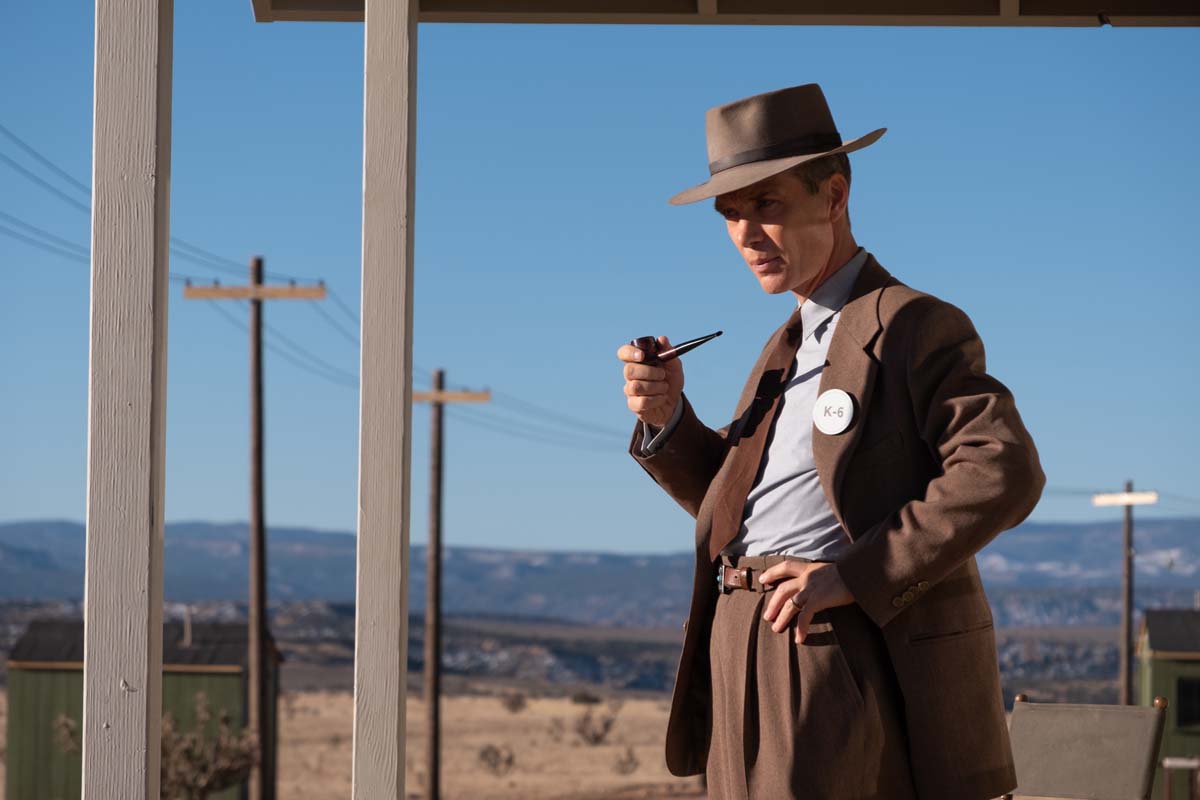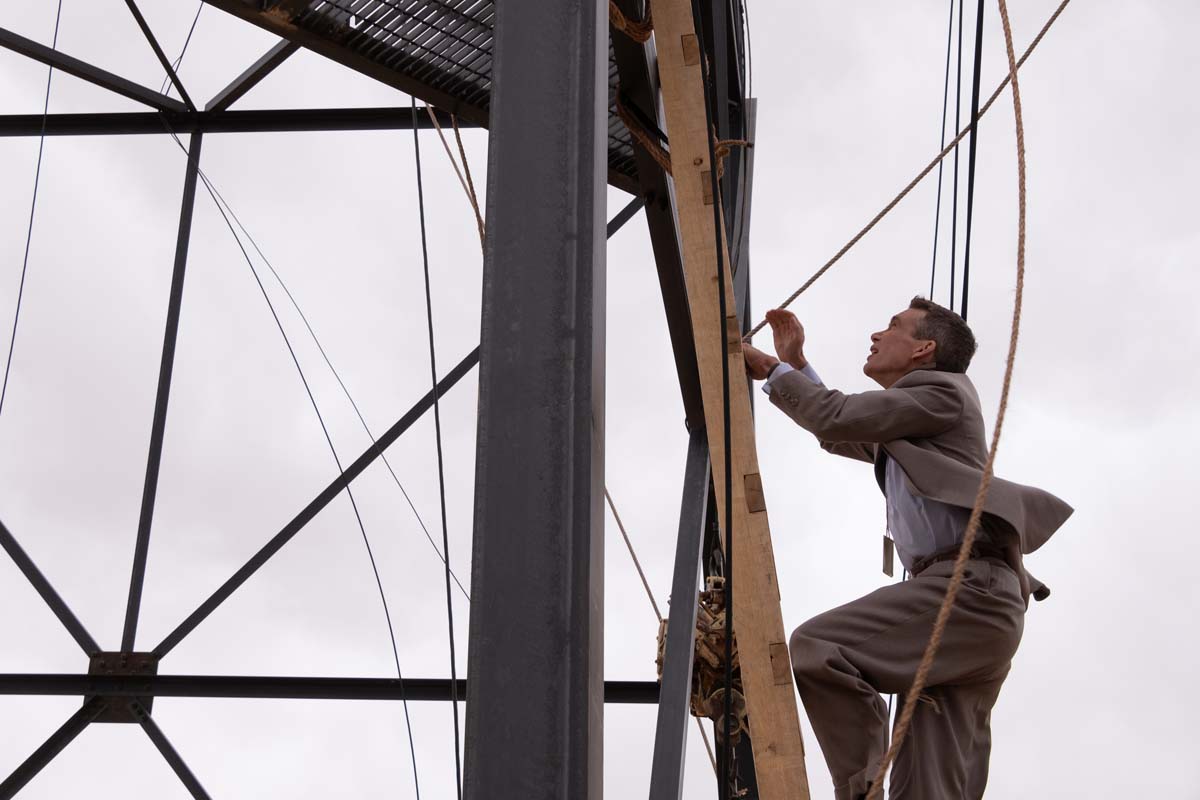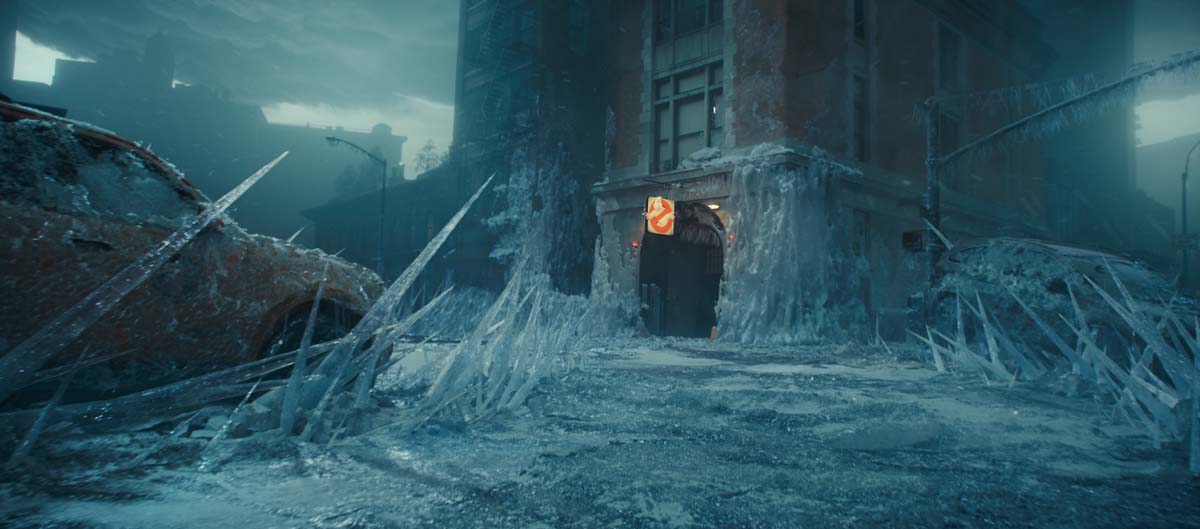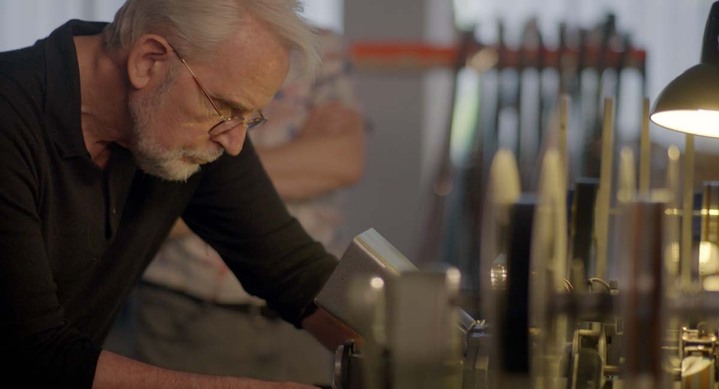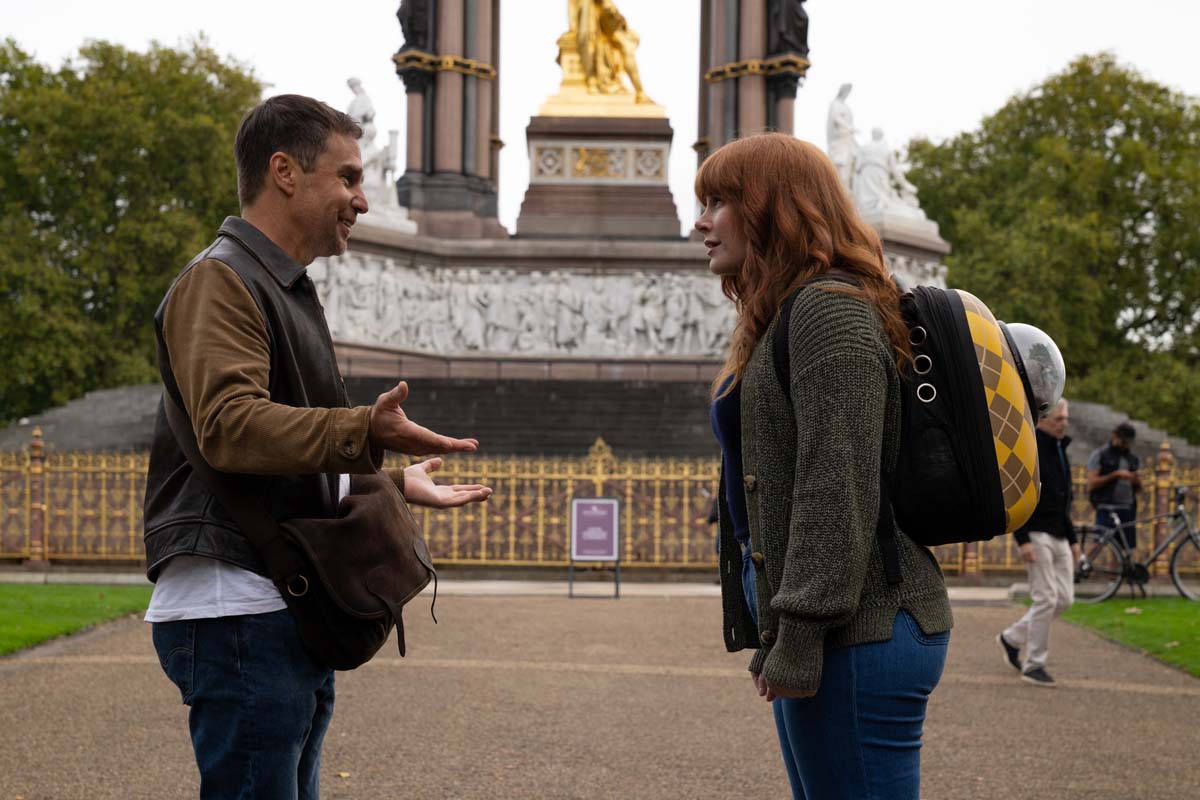Oppenheimer
Oscar nominee Jennifer Lame, ACE, and the editorial team discuss what it's like to work with Christopher Nolan, the power of intercutting, and more.
Today on Art of the Cut, Jennifer Lame, ACE, discusses editing Oppenheimer with some of the key members of her editing team: Additional Editor, Mike Fay, First Assistant editor (Avid) Nick Ellsberg, and First Assistant Editor (film), Tom Foligno.
Jennifer Lame was an early Art of the Cut guest when she edited Manchester By the Sea, for which she was nominated for a BAFTA and an ACE Eddie. She has since edited Hereditary, Marriage Story - also nominated for an ACE Eddie - Tenet, and Black Panther: Wakanda Forever.
Mike Fay was previously the Visual Effects editor on Bullet Train, John Wick 3, and Passengers, First Assistant Editor on Ghostbusters: Afterlife, and The Mountain Between Us, and editor on the feature film, A Shot through the Wall.
Nick Ellsberg was First assistant editor on Bullet Train, assistant editor on Ghostbusters: Afterlife, second assistant editor on John Wick 3, and editor on the feature film, Watch List.
Tom Faligno was nominated for an ACE Eddie for an episode of Curb Your Enthusiasm. He’s also edited the TV series Ballers, Altered Carbon, and Dispatches from Elsewhere. He’s also cut features including All for Nikki and Sweet Lorraine. Later in the episode, you’ll hear his background included working on Martin Scorsese’s Casino, Kundun, and The Aviator as an assistant editor under Thelma Schoonmaker, ACE.
Art of the Cut: Oppenheimer
Let me start off with Jen. One of the things that struck me throughout the whole film is this idea — these really cool visuals that went through kind of to show what Oppenheimer was thinking — they're like particles or sparks, waves, all these interesting kind of visuals. That couldn't have been in a scene bin that had to have been in a special bin of like, here's stuff for me to show sciency stuff.
LAME: It was in scene bins right, Mike? You put it in a lot of bins.
FAY: Yeah. We split them all up into particles or fire or explosions just sort of bins for some of the major categories. But then Jen and Chris could dive into them as needed.
But they didn’t have a scene number like: this is the fire for scene 27.
LAME: No, no, they didn't.
ELLSBERG: Well, sometimes they were for specific things.
Interesting. What was something specific?
ELLSBERG: The opening shots, that was stuff that was shot specifically for the opening, the Trinity plasma ball, that was always intended to go there. So some of it was slated for certain scenes, but a lot of it was general stuff to play with and figure out where to go.
FAY: Yeah, the black hole that was for the black hole, certain ones were more sort of universal. But yeah, there were certain shots tagged for certain scenes.
The movie's very non-linear. Jen, how much of that was scripted that way, and then how much of it did you find that you — for story purposes — needed to move things around?
LAME: Most of that was scripted. The way that Chris writes his scripts, he's incredibly meticulous, as you can imagine. So it's all incredibly scripted. All the timeline stuff is scripted. It's all in that script. The script is like the Bible for him. And I come in and read the script and we talk about it, but there's not much movement there. And he's refined it so many times it's pretty structured.
Let's talk a little bit about the use of sound design and what the value in that is. There's a couple of really great sound design moments that I loved. One would be the stomping of the feet that kind of built dramatic tension. And then, of course, the explosion itself and the end kind of victory speech in the gym that Oppenheimer gives and then kind of has these nightmare flashbacks.
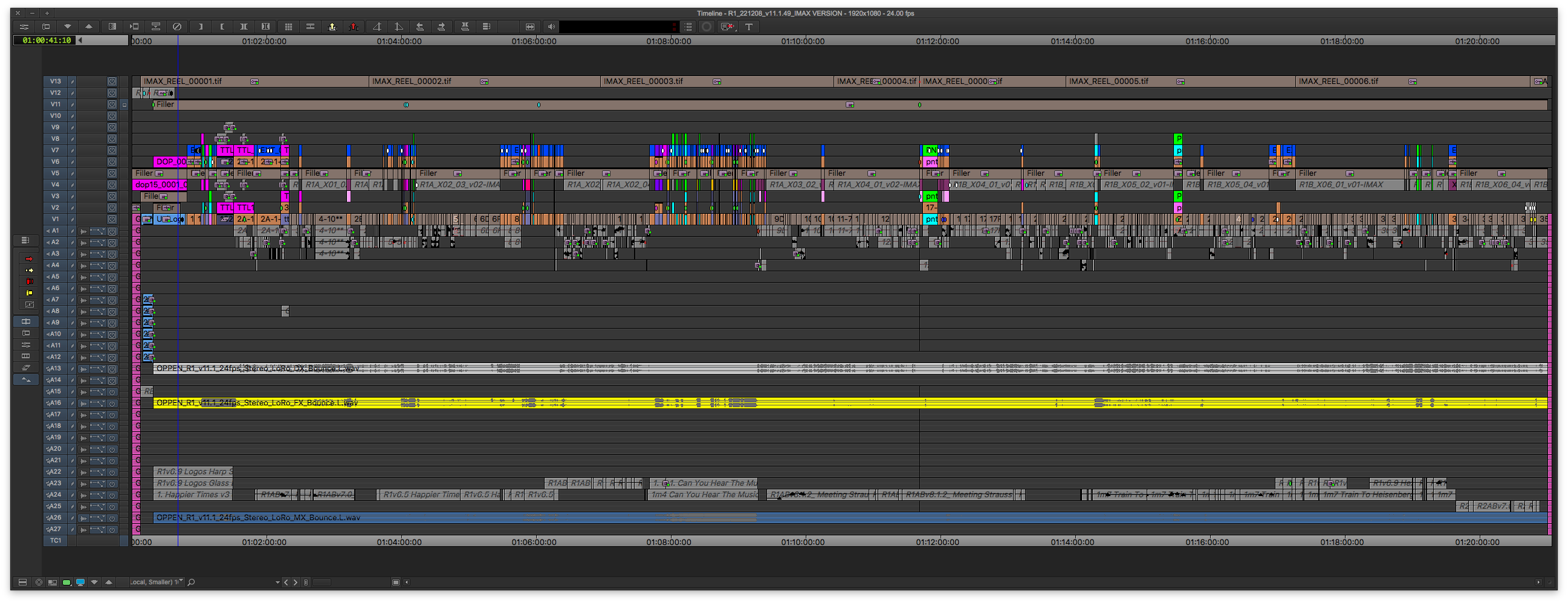
Oppenheimer Avid timeline for Reel 1.
LAME: The stamping is very much a part of the script. I feel like people are, like disappointed by that. But what I think is so cool about Chris and his scripts is that there's so much detail in the script and it's so exciting as an editor to read a script like that, to know that that's all embedded and that he wants to do all these kind of cool, interesting things and they're still very difficult to make work. So the stamping was very much a part of the script and before even came on, they had to do a little bit of a teaser because came a little bit late to this project. So Mike Fay actually had to start dealing with the stamps. And it's funny because, I mean, this is only my second Chris project, but I know that in all of his projects there's always some kind of sound. There's just something that, you know is going to be kind of difficult in a fun, challenging way. And I knew that the stamps are going to be difficult. They have to rhythmically build and it's human beings doing it. They recorded all of those live stamps in that auditorium. People get tired and people slow down. And Chris both wants it to sound natural, but also it has to have some sort of musicality and build. So it's like it's incredibly difficult to edit that kind of thing. Any time we would cut that I would have to call Mike and ask, “You gotta help us with the stamps.” You have to have a good ear to do it, it's really hard, but Mike had so many stamp string outs.
FAY: That was my personal nightmare: cutting in those stamps. That was something we shot and Chris directed all the extras to perform that way. The idea for that Fuller Lodge scene was that all of their voices go away and you just are left with their bodies moving. And for the stamps, I remember him kind of directing them to do that and they would always perform it in a very specific way that just sort of organically happened. That didn't make them the most flexible to edit because they'd be accelerating at their own rate and you wanted to elongate them or stretch them out. So that took a lot of surgery to do. It was laborious, but it wasn't really particularly challenging. Starting to figure out ideas for the particles or for the quantum world or even in that Fuller Lodge scene when the wall behind him begins to pulse and vibrate. That was a whole adventure of digging into libraries and starting to just sketch out what that would even be and trying to find things that wouldn't clash with music as well.
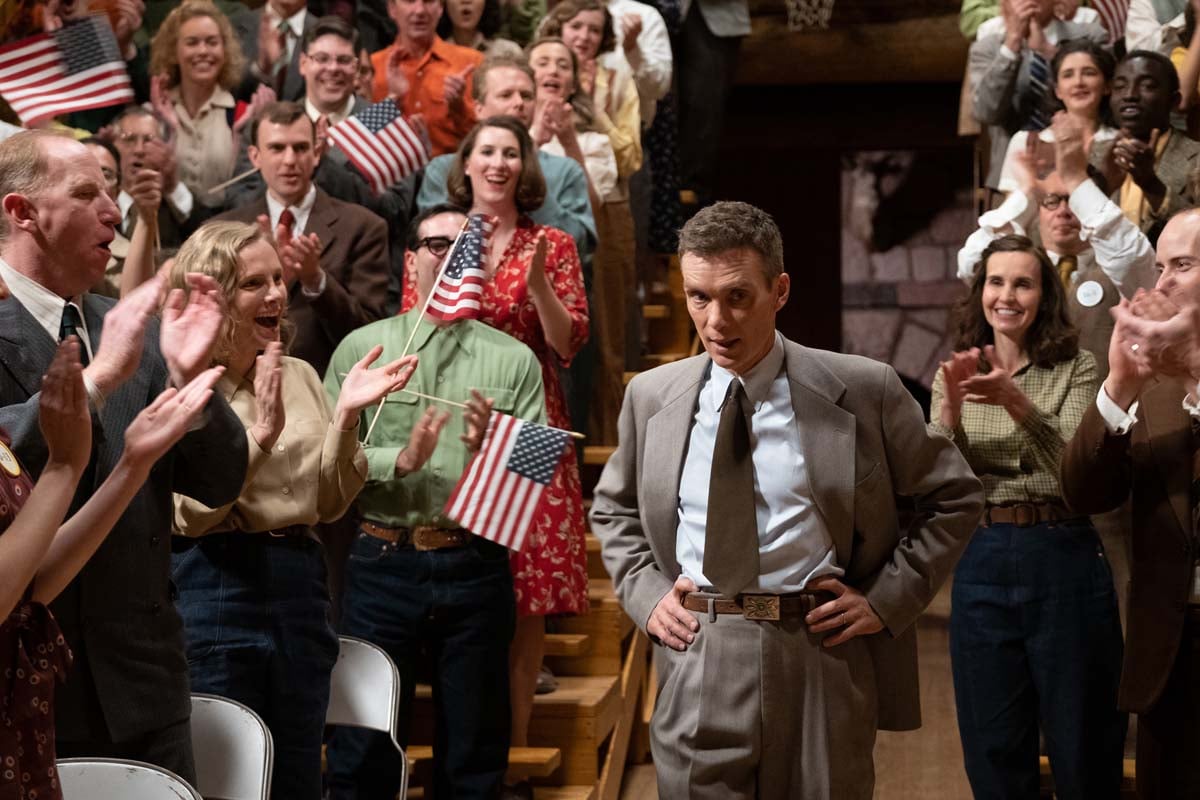
LAME: Or sound like music.
FAY: Chris didn't want them to have kind of a tonal quality to them. He wanted them to have something that would be a little more percussive, so that they’d play with whatever Ludwig was going to come up with for any given moment. So we formed kind of the beginning of that process of sketching things out. And then Richard King and our amazing sound team took it over and developed it even further for each of those things.
Tom, tell me a little bit about the screening of dailies, even on film. Explain a little bit about how things get shot and how things get screened and what you're doing with the film.
FOLIGNO: What we screened for dailies would be the 70mm five perf and also a reduction print of the IMAX 15 perf to a four perf 35mm so that's a real reduction, and it's just to get a look at it. Quality-wise, you wouldn't judge it there, but at least it lets you take a look at it on the big screen during dailies. So you've got two separate things going on and it's a team effort. We bring the film in, we log it how we have to log it so that an editor on an Avid can then sync those takes to sound. My main job was to put them into alphanumeric order basically on reels and make the reels about equal size so that they would fit in the can or they wouldn't be too big or too small. You have to get accurate measurements and all you have is a footage count from a camera report. Sometimes they're right, but a lot of times they're not, and you have to actually have the film itself to see it on a bench with a synchronizer and measure it to make sure you've got the right length. Then the Avid person would sync it up to a video that we make in the morning. After they finished printing. We make a video of the daily rolls — the rolls as they come off — and then we move them around a little, depending on if they were shot out of order or whatever. So we need to put that in order. And then I would check it on this machine called the Prevost, which can run 70mm five perf film and that also attached to a ProTools, which is what we get from the Avid to sync the sound, and that is married together via a shaft encoder.
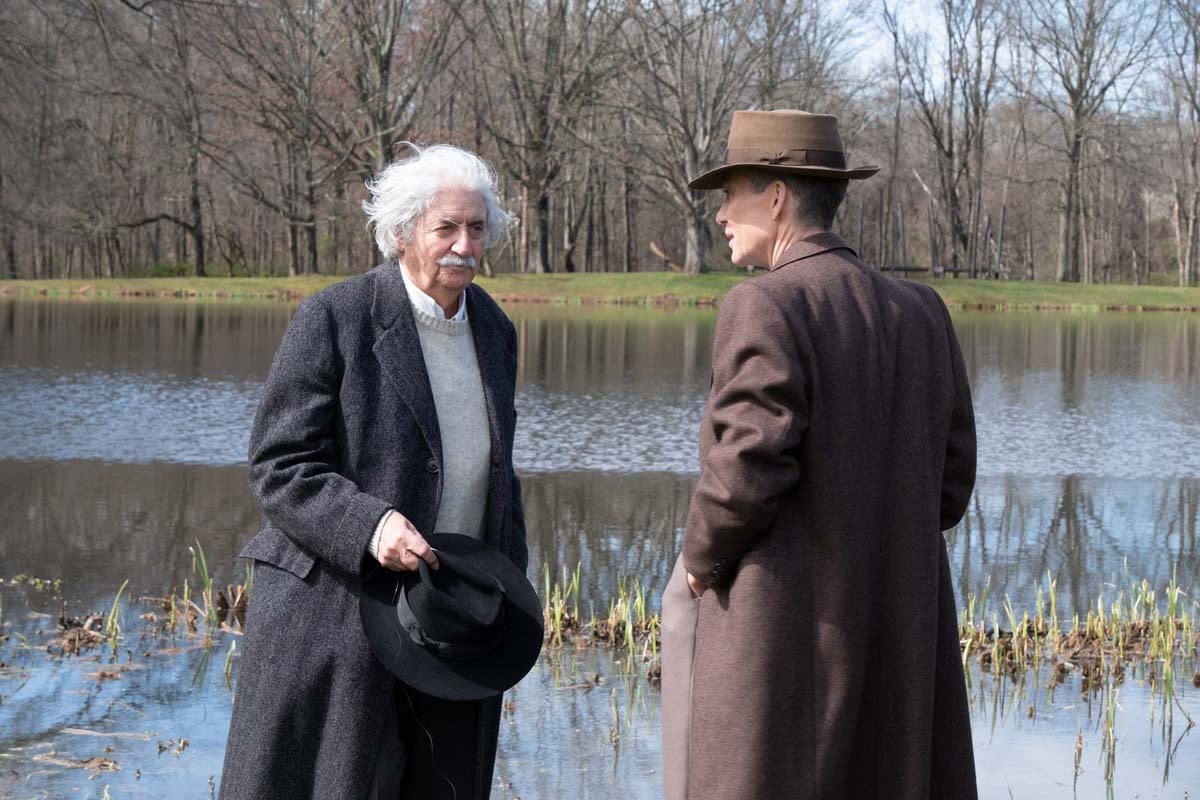
Mechanical to digital.
FOLIGNO: It sends pulses from the projector or the Prevost to the ProTools and that creates the link and it syncs up with those sound files we send to the projection booth. And they do the same thing there, except it's not on a Prevost, it's on a projector.
LAME: Mike and Nick can talk to the stresses about the dailies trailer.
FOLIGNO: I would prep it in the cutting room and then send it to them, and then that was their situation there.
LAME: We had two PAs driving the film between LA and New Mexico..
FOLIGNO: Because of the fact that they were shooting way out in the middle of nowhere, and the airports weren't very close in New Mexico. So we had people physically drive it from LA to New Mexico every day and they had sort of a tag team thing where they would meet halfway with another car and they would exchange cars. They wouldn't take the stuff out of the cars. They would exchange cars. If police saw this going on, you might arrest these people.
ELLSBERG: That almost happened a couple of times.
To explain: Jen mentioned the dailies trailer. You're talking about a physical trailer getting pulled by a truck kind of trailer, right?
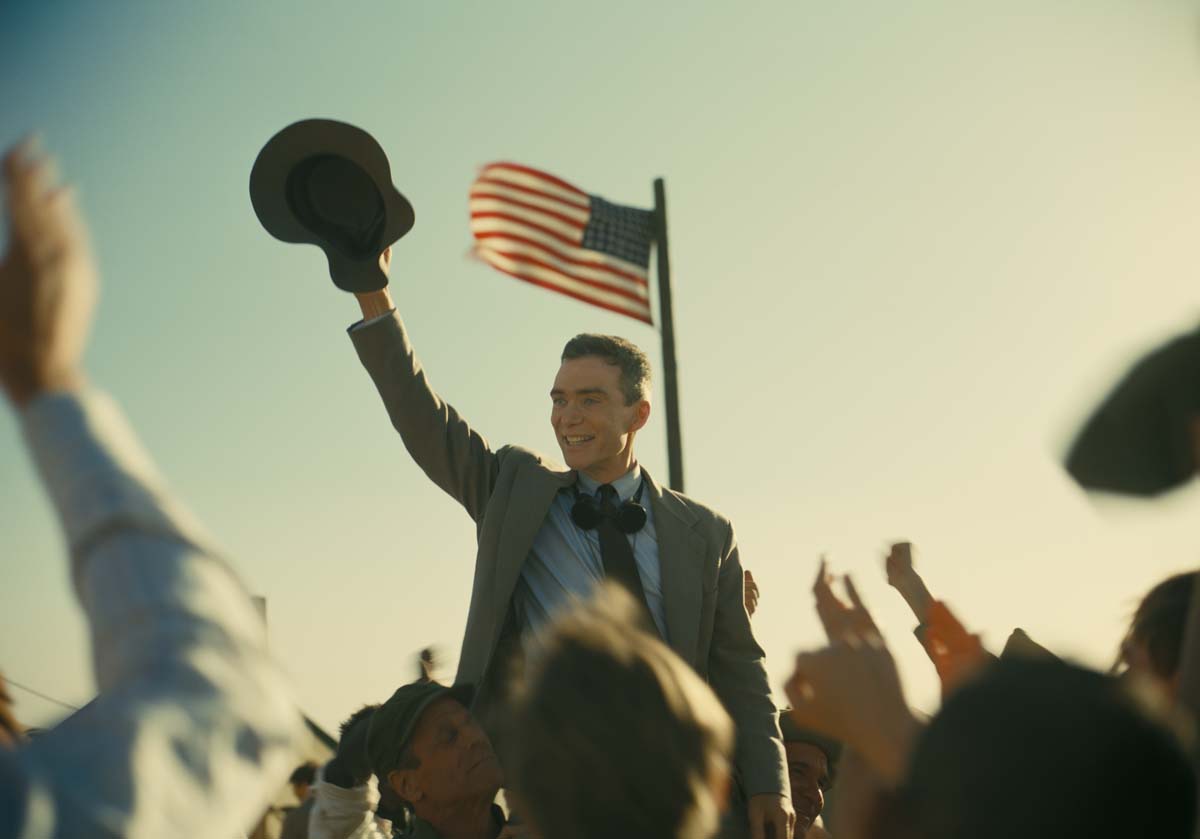
LAME: Yeah, with a projector in it.
FOLIGNO: Inside the 18 Wheeler, they had a few seats and a screen and a wall, and then behind that would be the projector.
Who was in those daily screenings? Did you get the DP in there? Or was it post? Who was in those screenings? And what's the value of seeing screenings as a group?
FAY: Chris has done this traditionally on on all his films but it's all the HODs — all the heads of department — we would do them usually at the end of the day, at wrap, everyone would race over to basecamp and hop in the trailer and maybe grab some food and sit down or we would sometimes do them before call — do breakfast dailies — and then sometimes we did them at lunch, kind of depending how much we had or where we were — what the day was going to be — if it was a night shoot, what have you. For Chris, it's an essential part to see what is actually on the film, to see what he's captured and to sit with Hoyte [DP Hoyte Van Hoytema] then reflect back and see if there's anything else they may need, which was very rare or if there's any other adjustments they may need to make for other scenes coming up, and then to just look for other technical problems and stuff like that. And then for Chris to let me know any sort of perspective on putting a scene together. His preferred takes. We had all that information from the line script, but if he had shot ten takes of something and he's like, I really prefer seven, he would let me know. It's such an essential part. And the foundation that that formed for him is he knew every single frame of what he had intimately. And so when he got into the director's cut with Jen…

LAME: Yeah, he knows the movie so well. I wasn’t in the dailies trailer on this one, but on Tenet I was. My first job — union job — was on a Sidney Lumet movie, Before the Devil Knows You're Dead, and we did film dailies every day. So I actually had experienced that before, even though I think Chris assumed I hadn't. But what I found so cool about it, which I also found cool when I was an apprentice editor on Before the Devil Knows You're Dead is just the camaraderie and the humanization of Chris directing a movie. He may seem kind of unapproachable and it's also stressful and I felt the same way about Sidney Lumet, but then you get into the dailies and everyone's talking. It's like all about the movie, and we're making a movie and if someone has a question it just feels like this camaraderie, like everyone's pulling together to do this thing and think it's so cool for the production designer and the costume designer to be able to pop into the dailies trailer and see their work and it's so inspiring: “Oh my God! Look what we're doing!” As opposed to working on a movie where you don't see anything. You don't know what's going on. No one's talking to each other. It's pretty special. The focus puller is there. If someone needs to come, they can come as long as they have a reason to see something they can come. So it's just a nice thing. I love it.
FAY: The room was generally packed. Everyone was always eager to see it and we would periodically do full IMAX screenings, 15 Perf, 70mm IMAX screenings of dailies, and we would do those — I think we did 3 or 4 over the course of production — and when the crew would go to those and get to be able to see everything in full 15 perf, it was such a morale boost for the crew to be able to look back on a location we had just wrapped and see everything from New Mexico, because we don't have any videotap.
LAME: Yeah, there's no PIX. There's nothing posted online.
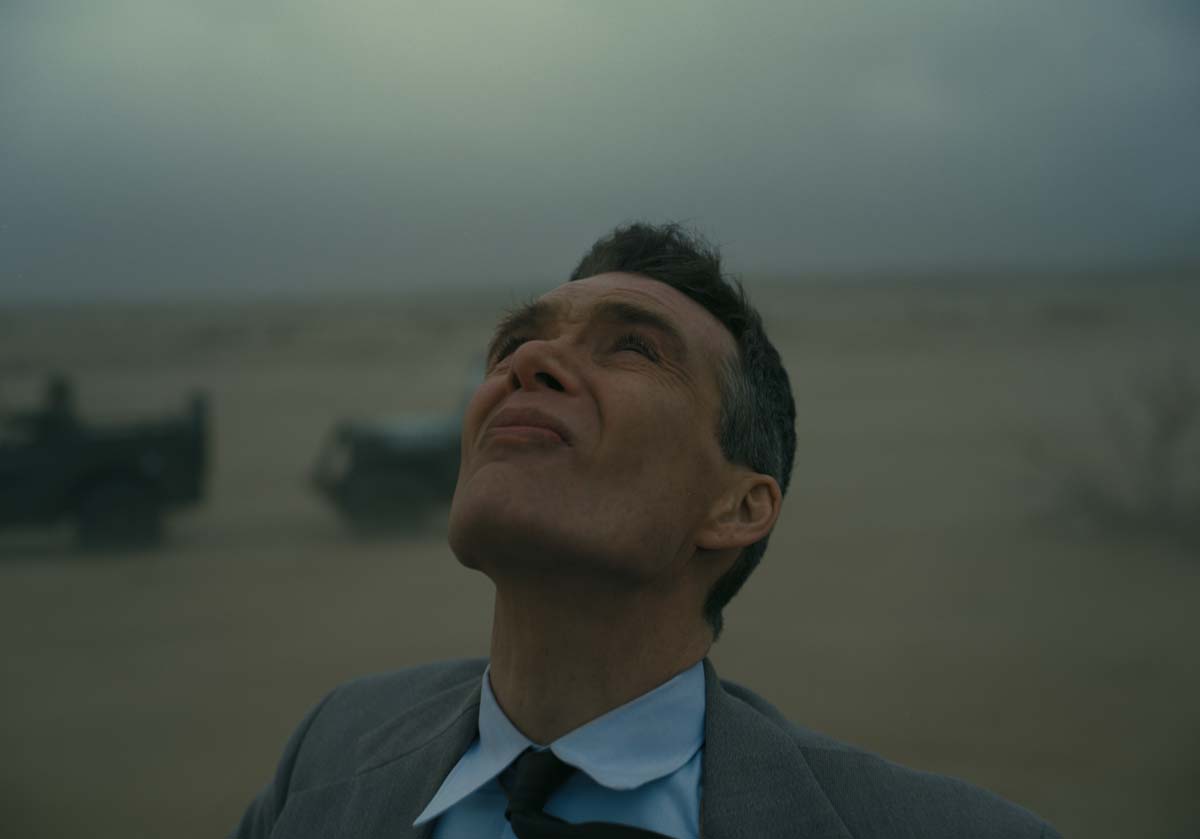
FOLIGNO: They see it in dailies on a daily basis, but it's 35mm reduction. They can't do 15 perf in a trailer. So when they get to see it at like citywalk or wherever they saw it when they came back here to watch it, it must have been great.
So the Avid folks were on location?
ELLSBERG: Yeah, the two of us were. Then the film team was in LA, and then we had more Avid assistants working with them, syncing the dailies and getting the Avid media prepped and sent back and forth. It really is an amazing logistical feat that we all pulled off.
FOLIGNO: The IMAX has a very small load. They start the camera and he says “action” almost before they hit sticks. Sticks is usually your sync point and then you're in sync, but the camera's not up to speed yet when they hit it. So the assistants have to eye sync almost every single IMAX shot.
LAME: They're trying to be incredibly efficient with the film. They don't want to waste film.
Tell me a little bit about Intercutting. Did you cut scenes — let's say, the Senate confirmation hearing or the break of the Senate confirmation hearing — would you cut that entire scene together and then intercut?
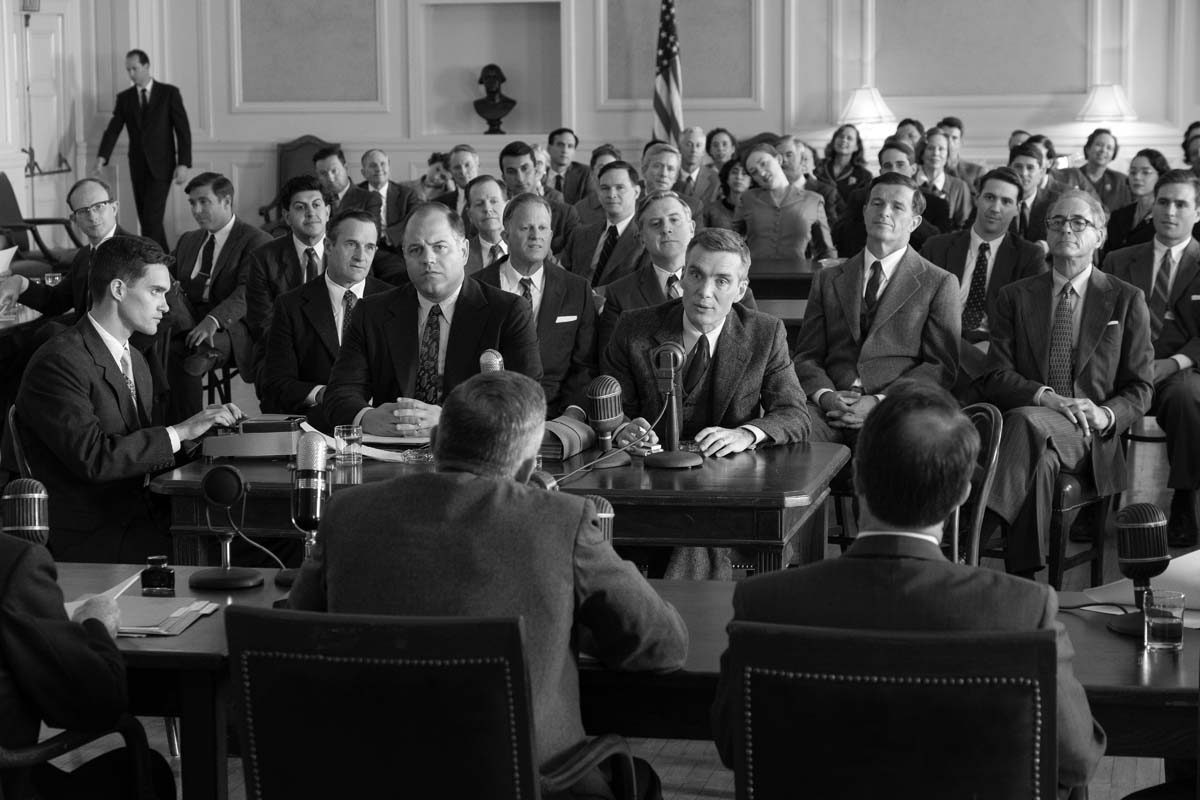
LAME: No. I followed the script because I came on a little bit late. I really wanted to organize everything by scene. But some scenes overlap. You're right, sometimes they would shoot and they would kind of go a little bit past. And so it was hard to kind of keep track of all that in my brain because I didn't want to think about it as one long scene, so I cut it according to the script. I don’t think I ever would cut an entire section. When I first came on and did my assembly I just followed the script. But it would get confusing if they reset or if they kept going past the scene. That was difficult.
ELLSBERG: They would shoot it all in a run. So scene 120 could actually cover 5 or 6 different scenes in the script. It would all be slated as one scene, but then in the actual script it would be six different scenes. Jen's idea was: “Make a scene bin for each scripted scene, and if certain setups only cover that scripted scene, put that setup in that one, and if it's slated as scene 120 but it's actually scene 130, call it scene 130.”
LAME: So there were duplicated scenes. He had duplicated shots in every scene bin.
ELLSBERG: Yeah, there's shots that covered this part, but it also covered this other part later on. And set up A…
LAME: You would write notes for me too, because it would get confusing.
ELLSBERG: It's very confusing. Even in sitting through daily screenings, you still had to go back and look at the lined script and see what it actually covered. It's very complex and very finely constructed on the page. It was not just a straight paint-by-numbers. Jen really had to figure out a lot.
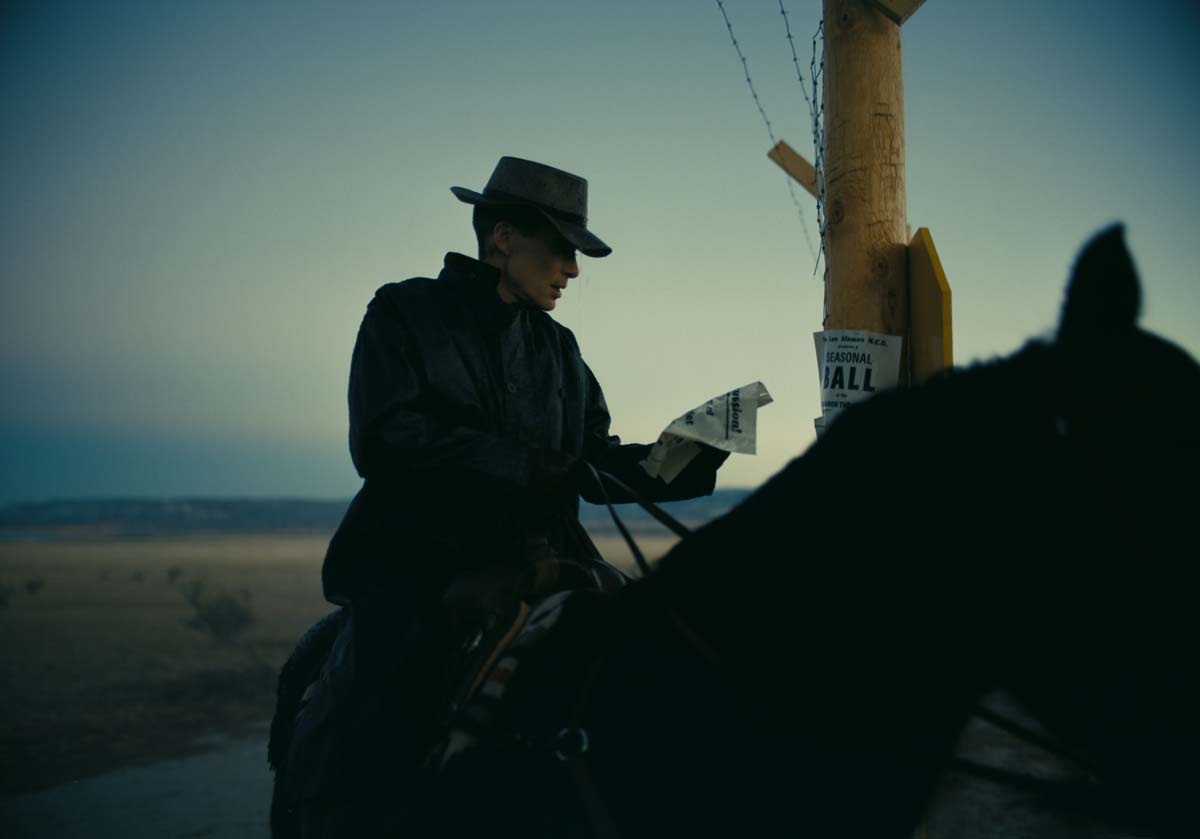
LAME: Chris is so meticulous and spends so much time and thought obviously in rewriting and refining the script to the point where it's so specific when it's finished. He has all the scenes in his mind. He has a photographic memory, so he knows all the scenes. So it would have been wildly confusing for him if I tried to cut them as chunks. It wouldn't make sense to him.
Every film changes when you get into post and you see performances and you see camera movement and all that kind of stuff. Did you find that the Intercutting had to change from the script once you saw it in its first context in an editor’s cut or director's cut?
LAME: It didn't really change much. I have such a bad memory for this stuff because I'm about to picture-lock on a new project right now. I've had two kids now and you always ask your friends that have a six month old what they did six months ago and they’ll say, “I don't remember.” It's kind of true. It's like a baby. You don't remember a lot of it, even though at the time it feels so important. But your brain kind of wipes it clean. But I do feel like maybe we did take some liberties with that first reel or two with the Room 2022 stuff of Oppenheimer slowly telling his story. I do think I remember moving a couple pieces around, but it was a big deal if we ever did deviate from the script. Chris is always open to it, but it's a big deal and we have to watch it a lot every time you move something around. So maybe we moved a couple of things around and towards the end I think we did take some liberties with some stuff in the last half of the movie, moving some stuff around with all the stuff in Room 2022 at the end — the big interrogation with all the friends coming in and testifying and stuff like that. But overall, I wouldn't say there was any huge structural changes. So it's all pretty in the weeds. If I explained it to you, you’d probably get pretty bored.
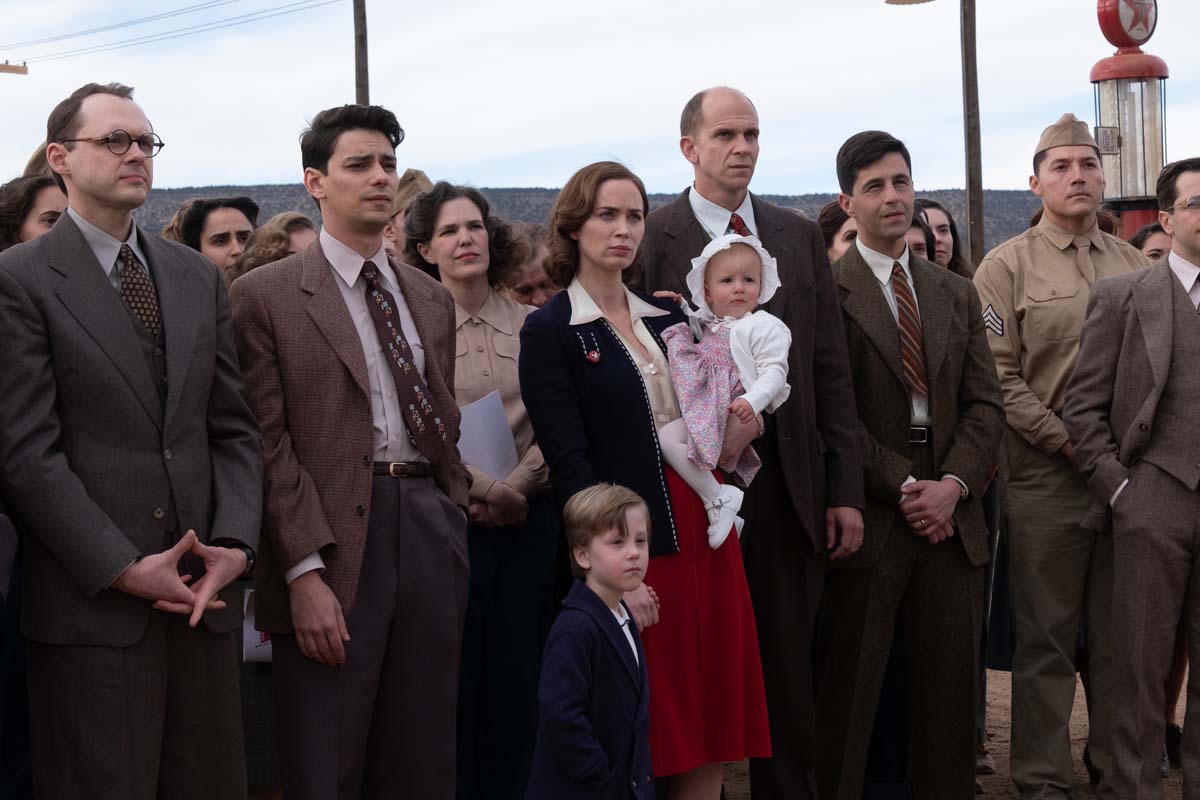
FAY: There were certain things like the scenes where they have to go and recruit all the scientists — that was originally written I think as all separate scenes from all those guys — and after you first went and kind of put it together that way, I think, you figured out, “Oh, wait, no, this doesn't we have to do something else here.”
LAME: That was not scripted as a montage. And then we kind of made it into a montage, which was helpful. That was kind of fun, like us playing around with that. But Chris is obviously so good at what he does, which is an understatement. But even when I was assembling it and stuff — because he came in really briefly when was assembling, then he went away — but I think he already even knew that that would probably have to become a montage. He kind of signaled to me: “Start thinking about that” because he already kind of knew after shooting it that it would have to become a montage. So it's very rare that he doesn't already see these things coming. But that was really fun because even though he knew it, he didn't know necessarily exactly how to do it. So that was fun, us doing it together, and we recut that quite a bit. That was fun to shape that. Every sequence is fun, even if it's meticulously scripted because the footage is amazing and it's a pleasure to cut, but also it has its challenges when you're working with such a brilliant script because you want to do it justice. I remember when read “Manchester” I thought, “Oh my God, this is an amazing script” and it plays with time as well. As an editor, I am thinking, “Okay, so I have to make sure that that works” because I just felt like with “Manchester” and with this movie and just in general, when movies play with timelines, the audience is very aware of it and you don't want them to feel like you're doing a gimmick. You want them to feel like it's important and it's part of the film and they aren’t thinking about it, which is what I learned with “Manchester” and I tried to apply to this film as well. It does play with timelines, but that's not what the movie's about. The movie is about what it's about, and we're using that in order to tell the story the best way we can. But we don't want people to be thinking about that all the time.

I was struck by Nick's point about how the scenes needed to kind of play as one whole scene, because otherwise some of those scenes would be very hard to act because you're only getting a couple of lines and you jump to the next thing. So they shot it as if it was a longer scene. And then, Nick, it was up to you to kind of break things down into the shooting script scenes.
ELLSBERG: Definitely it was a team effort. We were just moving so quickly that initially it was: “Here's everything for scene 93, just put it in bin.” And then when Jen started, she said, “I really need to know what other scenes it covers.” You could approach it like, “All right, I'm just going to watch the dailies. Okay, cut this part and then put the other part aside.” But it would get thrown off, I think, if you tried to do it that way. And then we would actually mark in a take, this is the end of scene 93. This line is when scene 100 picks up. And so Jen could use that to say, “All right, when I'm focusing on this scene, focus on these takes and these sections of the takes,” because Strauss in particular — Robert Downey Jr — the first leg of his role, they shot all of his New Mexico scenes in like a week I feel like. Very, very quickly. And then they picked up some more scenes with him in LA for later parts of the film. Most of his role was shot very quickly and with the Senate aide and the council in the New Mexico State Capitol. They just had to just get through the material.
It's interesting, Jen, that you said that you kind of wanted to go in order. That's not something editors get to do usually, right? You got to cut all the Senate hearing stuff because it was all shot at the same time and then move on to something else because it gets shot later. But did you try to go kind of linearly when you jumped on?
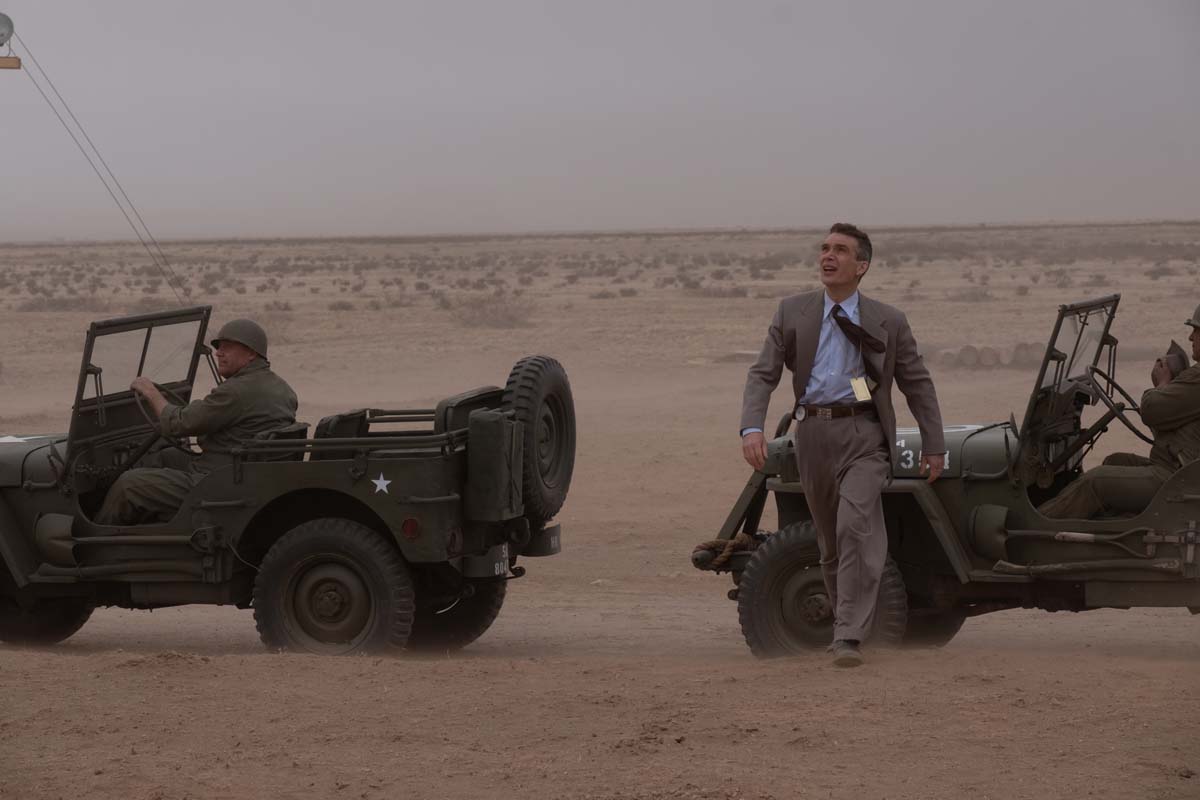
LAME: Well, when I came on, what I did was I just started from the beginning of a script to go all the way down. When I came on, I came on the day or two after they wrapped and they came back to LA, because I was on a previous film. (Black Panther: Wakanda Forever) so Chris gave me, I think, four weeks and then we both got Covid, so it turned into five weeks. I just had to start at the beginning of the script and work my way through it. And Chris was really nice knowing that I didn't have nearly as much time as if I were on the actual shoot. So he said, “Don't feel pressured to put the whole movie together. The main thing is just want you to watch all of the footage and just be as familiar with the film as possible so we could hit the ground running and work together, putting the movie together.” But the best way for me to watch all the footage and be familiar with it was to just assemble it for my own brain and also — to your point — to get used to the timelines and thank God I did too because as I was going through, I saw that these scenes would just run through and I had to break them up into the intercut scenes because it's so integral to the movie to know every scene that takes place in that room and in the Senate in terms of like each snippet because the way that Chris wrote the script, those little pieces, those little scenes, I needed to memorize those and know in case we did move them around. They all existed in the script where they were for a specific reason. So it would have been incredibly counterintuitive to the process for Chris if I'd cut them all as one section, because then wouldn't be understanding and learning the film, if that makes sense.
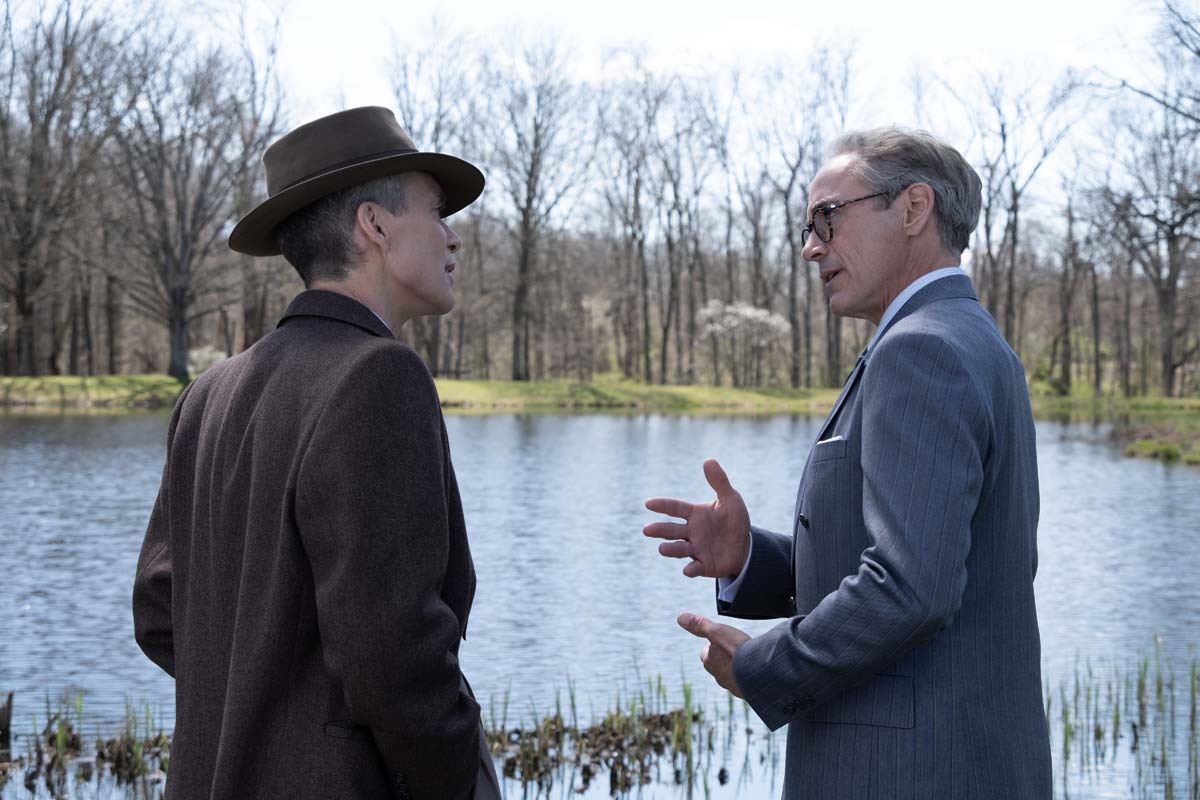
So I went from the beginning and that's immediately when I honed in on like, “Oh God, sometimes for this setup they shot through this scene, but for this setup they didn't shoot through.” And if I waste so much time thinking about this, I'm never going to get through the movie. So that's when I called Nick and I asked, “You have to help me organize all this stuff. While I'm cutting I need you to be organizing it because I only have 4 or 5 weeks.” And it was hard. So I started from the beginning of the movie and I worked my way through and I got all the way to the end literally the day before Chris and I started working together. I think I made it to the end. I wasn't sure I was going to. And I definitely skimped on the Trinity section. I didn't meticulously cut that section. I think I just dropped in some placeholders. I had to get past that because I knew that the stuff after that was incredibly complicated in terms of the intercutting between Room 2022 with Robert Downey Jr. and so I had to push past Trinity to get to that part of the movie and to familiarize myself with it, because I knew when Chris came in and we were sitting together, I had to know everything that happens in Room 2022 between Jason Clarke and Cillian at the end, intercut with Robert Downey Jr — Strauss's character — I had to know exactly when those intercuts were scripted and in case we were to change them line by line, because again, the way that Chris wrote it was so specific and it had this build to it. And if we were going to change it, it was going to be a big deal, and I needed to know exactly why he built it that way and if I wanted to change it, exactly why. So I had to go in order for that reason. But it is funny that I wasn't there on the shoot, because you're right, if I was there on the shoot, I still would have cut them as little scenes — I wouldn't have cut them as big pieces — but it was actually weirdly helpful for this specific movie to come on later and go from the beginning to the end like that. It's so funny that it's helpful with such a non-linear movie to work in such a linear fashion, but it actually worked out incredibly well, even though I was really nervous to come on so late. Most editors do not prefer to do that because you're immediately behind. The minute I got there, I had so much footage to cut. It was intimidating.
FOLIGNO: I heard we got over a million feet.
FAY: Yeah, I think it was like 900 some odd thousand.
FOLIGNO: The guy at the lab, Christian Straub, told me that. He said, it was 1,000,000ft. I said, I'm surprised! But a million feet of 70mm is pretty amazing.
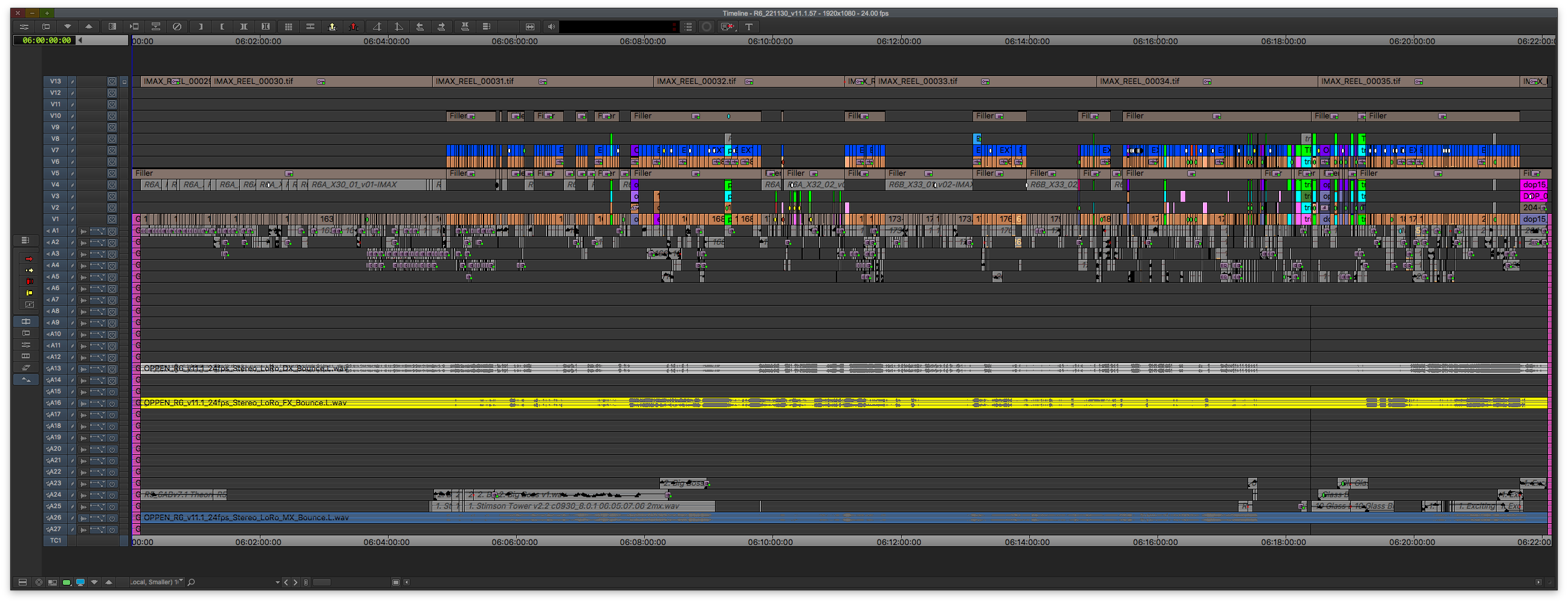
Screenshot of REEL6 of the Avid timeline for Oppenheimer.
The timeline includes the two formats - IMAX (1.43) + 5PERF (2.20) - in their original aspect radios on tracks V1-V5. The tracks above that, V6-V10, contain 2.20 center extractions of all of the IMAX shots. So, when viewing from V10 down, you’re watching the whole movie in 2.20. To watch the movie in IMAX 1.43, the assistants have to replace the 3D Warps on V5 above the 2.20 sections with a new 3D Warp that will letterbox that material inside of 1.43 viewed from the V5 down.
The track breakdown:
• V10 = 2.20 Letterbox Mask (Viewing from here you can watch everything in 2.20)
• V9 = Titles
• V8 = 5p VFX Film telecine
• V7 = 5p Extractions, DOP / OPT Film telecine, 5p VFX QT renders
• V6 = 15p + 35mm clips scaled up to fit the full frame of 1920 x 1080
• V5 = 2.20 Letterbox Mask - OR - 1.43 Pillarbox Mask (Viewing from here you can watch everything in it’s native AR)
• V4 = 15p VFX / DOP / OPT Film telecine
• V3 = 15p VFX / DOP QT renders
• V2 = Original 15p Clips for VFX Shots when the QT render is on V1
• V1 = Original 5p + 15p Clips
Michael, Tell me about the editing dailies process. What was it like for you before Jen came on and what were you trying to get accomplished? What was your goal knowing she was coming on later?
FAY: My goal was twofold. One, to cut all the scenes so I could tell Chris if he was missing something when I met him originally, he's like, Look, I just need to know if I've got it or not. So that was the first primary objective. But then the second one was to get as much stuff cut for Jen if she needed to reference something as a starting point because I knew she was going to be coming on late. But for me, the scenes with Robert Downey Jr.’s testimony where they would slate it as one scene but it would cover five scenes — when that would come in, the way I work, I build basically stacks or line-by-lines. So I take all those takes, break them all down, get all my lines, and then start assembling from there. Do the first scene, do the second scene, do the third, the fourth, do the whole thing. And then those would be ready to assemble once I got the connective tissue to kind of put those together. And since the Princeton material came later, all the LA material came later. So there's holes all over the place. Certain portions of New Mexico I had that I could put all together. Certain portions going from Robert Downey Jr.’s testimony to Los Alamos to Princeton — I would have that stuff to put together — sometimes the Los Angeles stuff. I wasn't able to get to all that stuff. Just trying to get as much stuff assembled as humanly possible. I was really kind of wearing two hats for the first portion of the show, assembling, then also playing this role that has traditionally been in Chris's world of kind of an associate editor position, which is someone who is kind of overseeing the workflow of post. I was there for every daily screening, helping figure out the workflow with the lab, the workflow for dailies, and then cutting feverishly every opportunity I had.
Do any of you remember the first time everything got cut together: how long it was?
LAME: It was like 3:30, 3:20.
FAY: I want to say it was 3:25. I think that was Jen's first assembly with Chris. That was screening one or something.
There's a very efficient sequence — storytelling-wise — when somebody comes up to Oppenheimer and says “They split the atom!” And he says, “No, that can't be true.” And and he goes to the chalkboard and he's trying to do the math and somebody else goes to the experimental lab and they're trying to actually split the atom, and in like 30 seconds or a minute, it seemed very efficient to me, very economical. Did you find that efficiency early or did it happen over a process?
LAME: That specific little piece you're talking about: I think Oppenheimer is chasing the guy down the street and then he goes into his classroom and then he starts on the chalkboard. That's just an example, I would say, of Chris's incredible efficiency and also Hoyte’s.
That really cool shot by the chalkboard where he’s furiously writing and then it cuts and he stands back? That’s just a really great, clever directing and writing mechanism of just efficiency. I can’t really take credit for that particular moment. That’s one of those moments where you’re editing a movie and you think, “Oh, this is amazing!” And it’s just so fun to edit because it’s clearly so thoughtful, that little piece. He’s with Florence Pugh, he sees the guy running, he runs back. He says, “They split the atom! They did it.”
He does the chalkboard thing. He goes into the room and then they have that moment where you know what everybody’s thinking. That section — that little piece — it’s a great example of helping make my job easy in the sense that there’s so much story to cover, and Chris did such a good job, obviously writing it and directing it — him and Hoyte together — just making these efficient moments feel so energetic and beautifully shot. But I remember when I saw it, I thought, “Wow, that is so cool how they did that.” It was just great.
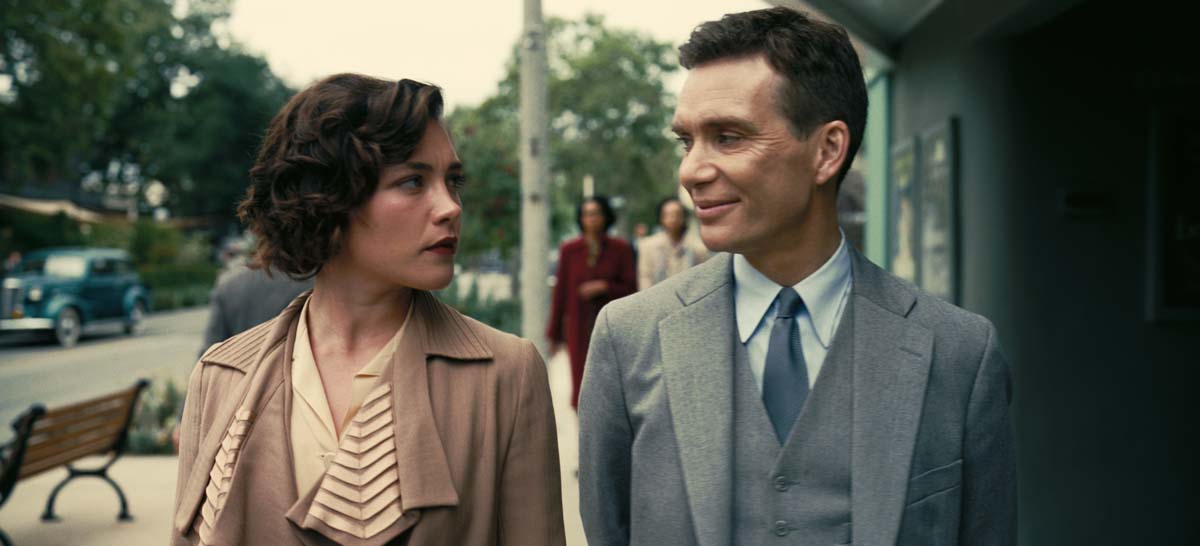
Another super powerful scene is the powerful intercutting between Jean — Florence Pugh's character — at the hotel, and then the security clearance hearing where Emily Blunt — as Oppenheimer’s wife — is listening to the fact that her husband was at this hotel with Jean. Can you talk about intercutting those and just choosing shot size, anything to make that as emotionally powerful as it was.
LAME: First and just kind of like watched all the footage and I think shot size was important, but it was also that we just really wanted to get the most important performance. I don't think we had a specific plan of what size shot to be on when necessarily. I think we really just wanted the most emotional performance between Florence and Cillian in the actual hotel room. That scene — I find that scene to be kind of heartbreaking and I think it's one of the few scenes in the movie that doesn't have music in it. It's just a very quiet, peaceful, devastating part of the movie.
I remember when I read the script. I was just wowed by that section. I was just kind of curious how he was going to pull it off. On the page it read so well and it was so emotional, but it seemed like a difficult thing to pull off. When you read that scene with her in Room 2022 with her on top of him and Emily watching. But they just nailed it. It’s just so devastating. Cillian looks older, but Florence is the same age, which really makes me feel really emotional.
The whole thing is just so sad. Again, that was a scene that we spent some time on it, but it was pretty easy to cut because the performances were just amazing and it just worked. It worked really well. It’s just one of those things that was on the page and it translated and everyone killed it and came out and it was great.
Oppenheimer says in the film that politicians won’t understand the power of the bomb until they've used it. I think that editing is similar. Do you find that sometimes there's no point talking your way through an edit? You just need to show it?
LAME: Oh yeah, totally. Yeah. It’s funny too because if I come in and I have an idea and start explaining it to Chris, he’ll say, “Just show it to me.” Because sometimes I can blabber on, as you can tell. It's true. It's very similar to editing. That is like a funny thing that you picked up on. I think editing is just a very difficult thing to talk about because I've spent so much time in that room cutting the movie and I'm sure so many interesting things came up, but I don't remember all of them. You're just in this thing and you're so locked into it. And then when it's over, you're just so happy and relieved. Then it just exists in this world as this thing that just came out and it's really hard to articulate what that process is like.
FAY: It was a mad dash once Jen came aboard. It was a mad dash from from day one of shooting, but once Jen came aboard, there was that ten week director's cut deadline looming ahead of us. We do screenings every week and have guests over and stuff, so you have that ten week deadline, but then you have every week a deadline that you're aiming for and that all of us were aiming for to get the cut ready. And it just imbued the entire process with this momentum and this forward push that was unlike anything I'd ever been a part of before.
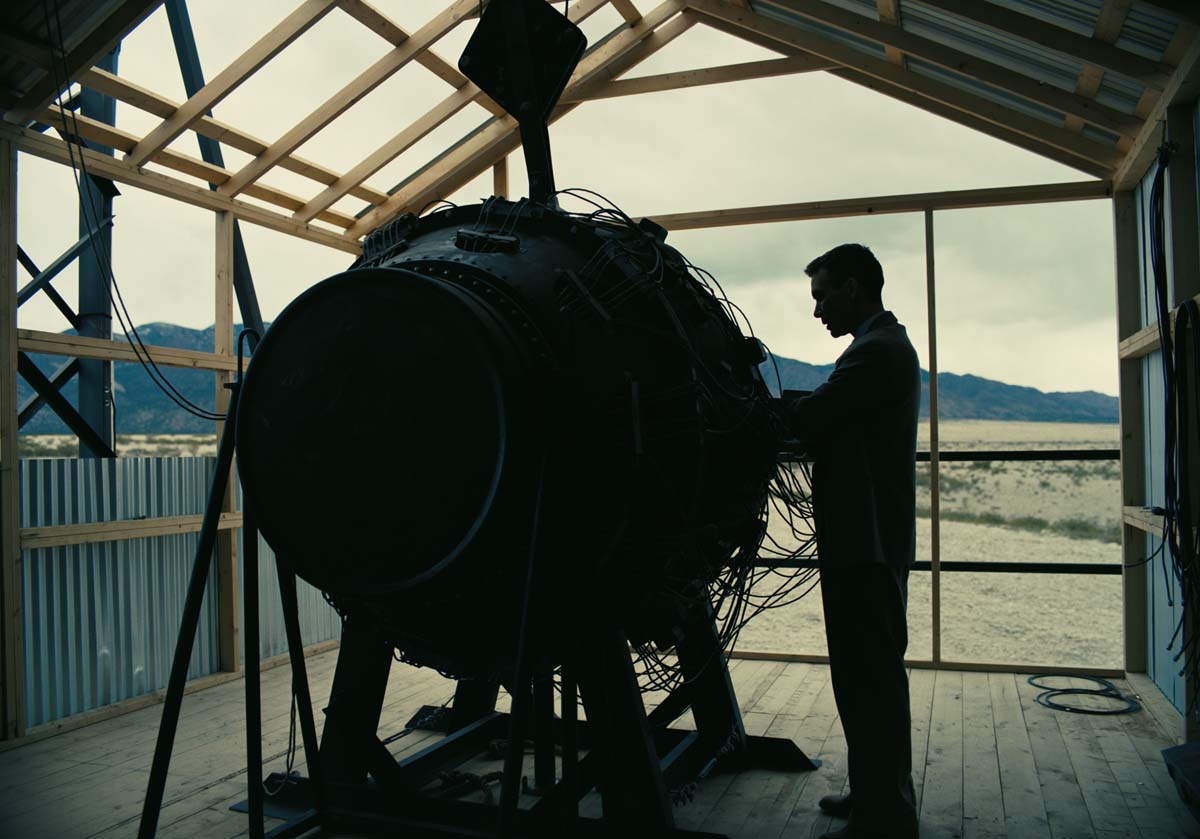
LAME: I tried to mentally prepare Mike and Nick for the Friday night screenings because remember when I came on to Tenet, John Lee mentally prepared me for it. It's difficult. It's definitely difficult. And Chris knows it's difficult. He gets it, but it's his process and it's just an adrenaline rush. And he kind of needs that, and I totally get it. I'm a similar personality, so it works for me.
It causes me anxiety and stress, but I think it’s a good anxiety and stress. So I’m into it, but I can see how it would be difficult for some people, but it’s a lot. Every Friday we’re screening before the director’s cut. So I had whatever you’re allotted for an editor’s assembly, and then whenever that clock starts ticking for Chris’s ten weeks, he does not mess around with that ten weeks. He does not go a day over, a day past.
And he likes to screen the movie as much as possible before he presents it to the studio because he wants it to be in excellent shape. So the way we do that is we screen it at his house just for like 1 or 2 people. And again, it’s just to force us to have this deadline: “Okay, by this week we have to do the Trinity section. By this week, we have to do a pass on these three characters” and then it’s just this momentum that keeps going until then you present it.
FOLIGNO: When you talk about screenings, I want to just note that not every Friday night did we do a film screening.
You'd need to conform a print for a three hour movie in a week!
LAME: To your credit, you are conforming the print for the director's screening. So we do screen on film for the director's cut, which is incredibly nerve-wracking because Chris once said to me, “I like the anxiety of knowing the film could break.” There's something about screening a film for the studio and you still have that adrenaline rush of the film could break. Like we don't know what's going to happen, as opposed to it being a or DCP or an Avid output. And so the whole time we're doing those Friday screenings, yeah, you guys aren't doing a film conform each week, but you are conforming each week as we're going, right?
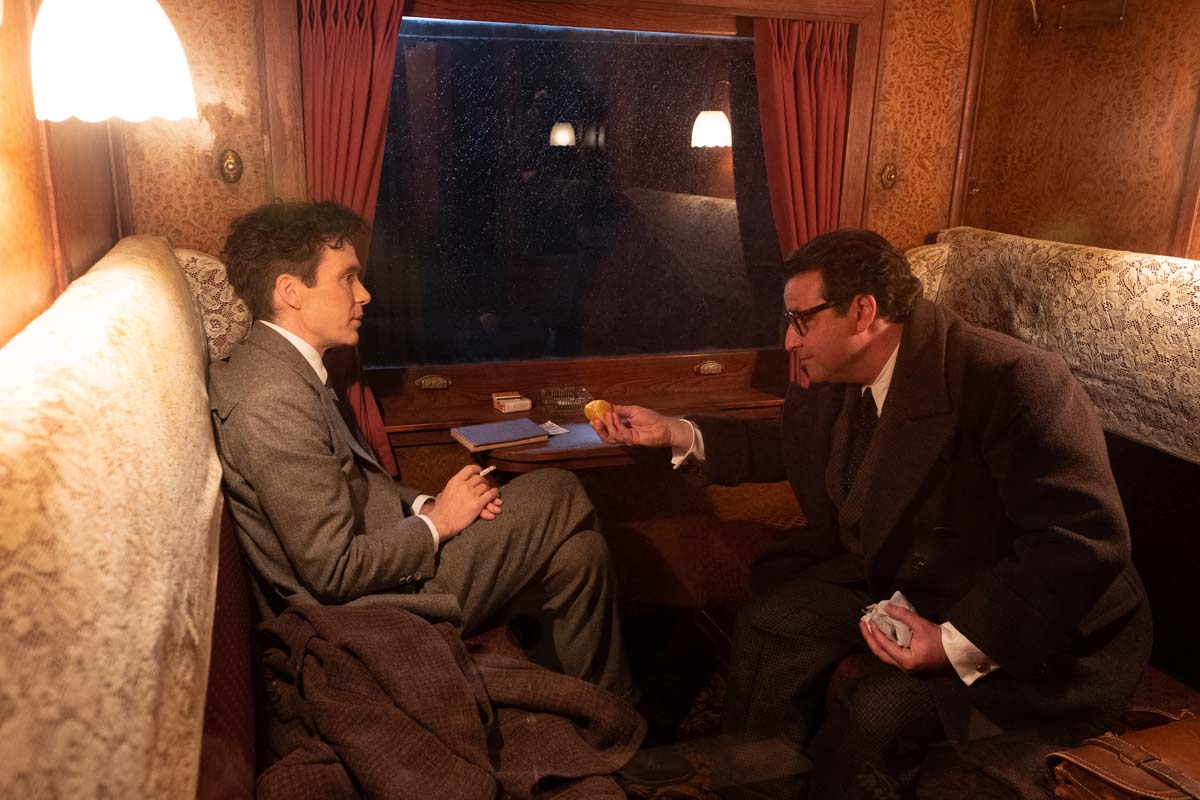
FOLIGNO: Yeah, I'm not saying we're not busy, but that's super pressure. We would need a team of probably 15 people.
FAY: The ten week director's cut — just to kind of put a finer point on it — we shot a large portion of this film and IMAX, and so the director's cut screening was designed to be a five perf 70mm screening. So for all of those IMAX shots, we needed to create five perf versions of those shots on film in ten weeks. So we had this massive machine that needed to kick into gear as Chris and Jennifer were cutting. At the beginning of those ten weeks, we did not have shots locked. Did not have shots ready to start optically reducing down to five perf. But at a certain point we got approved shots and we were able to start that entire mechanism. And our amazing post supervisor, Tina Anderson — Tina was kind of like this angel figure for us in post who just kind of helped us…
LAME: She's also like a celebrity figure in the film world because she works with Tarantino, Chris now, she does all of Ben Affleck's movies. She's amazing. She's just such a badass. And she worked with Billy Goldenberg. I've never met anyone that's just so good at their job.
We're going to lose you in a couple of minutes, right Jen?
LAME: Yeah, I do have to go to a meeting.
Okay. I want to give you two quick questions, and I can continue with three guys maybe after you've left. But I wanted to talk about the Trinity scene, especially the buildup, like the pressure and the tension as the countdown is happening. And then after the explosion, the sound design of that and choosing to not have an explosion sound on the biggest bomb that's ever gone off.
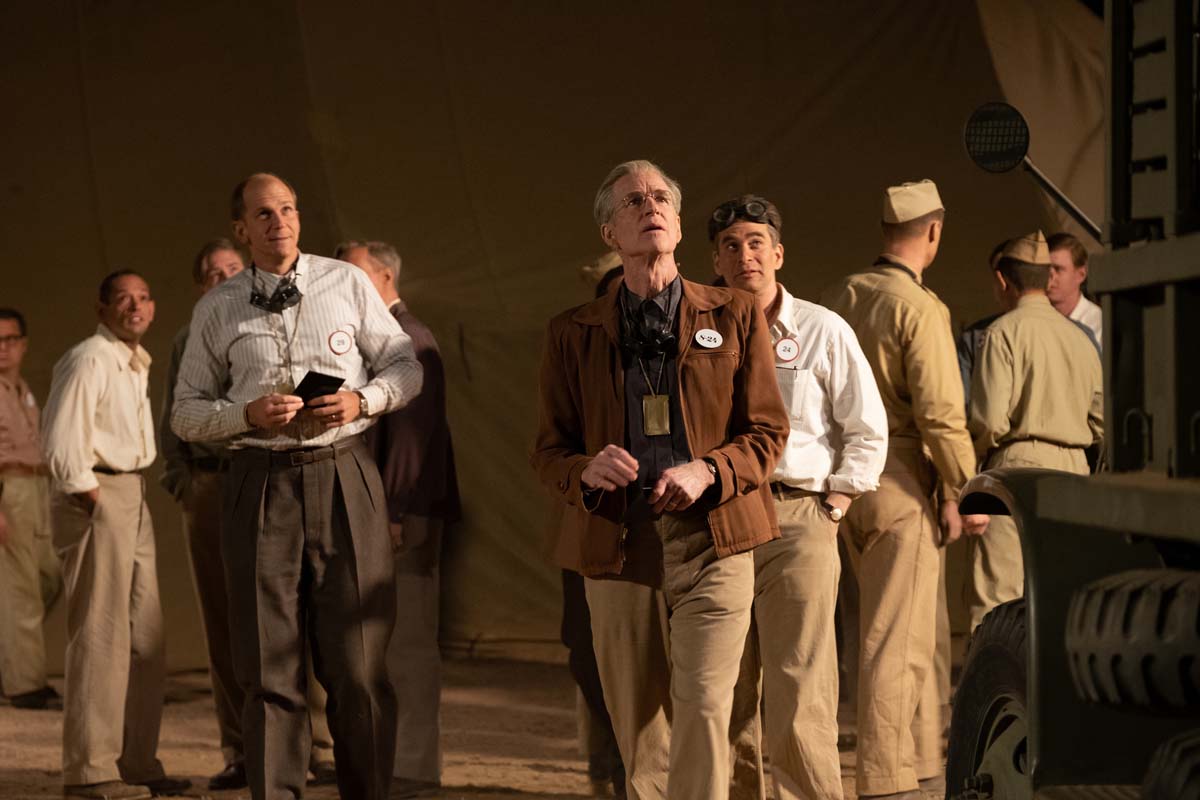
LAME: When did my editors assembly kind of breezed past that because didn't have time for it, Chris and I just went in there and pieced it all together piece by piece, built that tension. We had a piece of music that Ludwig and him had been working on that they kind of knew was for that section. We used that music. So Chris never uses temp music. He either uses music that Ludwig gives him or we have no music.
But I believe when we first pieced it together, we did have kind of a rough temp of what that was going to be like from Ludwig. It was just kind of like putting it all together, building that tension, going back, continuing to build the tension. It’s just like a very specific thing. And Chris is incredibly good and meticulous at building tension like that and a lot of his past movies had these incredible sequences: the bank robbery at the opening of Dark Knight. He’s so great at those sequences, and so it wasn’t something he was ever nervous about or worried about.
He and Hoyte just killed it. We had all the pieces to work with. It was more just really fun to do. I think we did it in a couple of days and it didn't really change much. If anything, we would add a little piece here. It was kind of just this thing that we built that we just kept tweaking, shaping, like building a sculpture or something. But the pieces were all there and it was never a moment of like, “Oh, we're missing something or we don't have something.” Chris never does reshoots. We had all the pieces there.
It was just so fun to build and play around with. The music is incredible. The performance is incredible. The silent delay was written into the script. It’s accurate to what actually happened because the guys are so far away from the bomb that they didn’t hear it. I forget what the exact number is, but I think we’re pretty close actually to what it was. So that’s actually realistic and we try to set that up earlier in the movie. There’s slight delays on some of the explosions. So that’s all real. That wasn’t a device or anything.
It was written into the script. I edited the breaths meticulously. It was just all so fun. Everything about it was so fun because when you’re working with a director at that level, it was just a really incredibly fun sequence to put together. But it came together pretty quickly, and we didn’t change it much except just to make it more tense at moments if we could. And that was the fun of it. The minute we put it together, it just worked. And so it was one of those things where every Friday Chris would ask, “Could we make it better?” And then we would try to make it better.
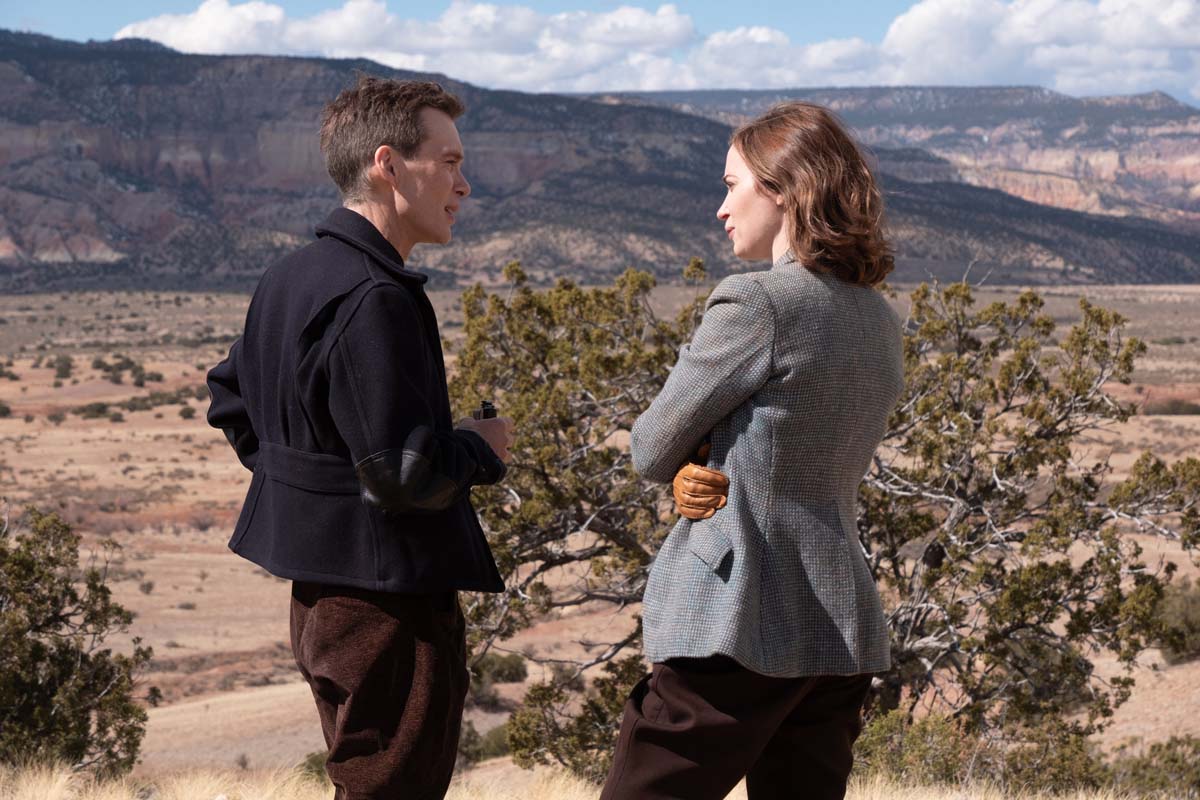
What is the actual collaboration process like between the two of you? How does he like to work with you? How do you like to work with him in the room?
LAME: I always talk about how efficient he is with time, so it's both like one of the more like relaxed experiences I've had, but there's never a moment we’re not utilizing. He starts pretty early in the morning. I come in — usually pour some tea. He'll pour me a cup of tea. He drinks tea throughout the day and we just work, but we take breaks when we need to, but we kind of work from right when we start till up until dinnertime and we just work through the film.
With him over your shoulder? Next to you? In front of you? What's the dialog?
LAME: We're just talking about the film. Every week we kind of have an objective. We start at the beginning of the film and we work our way through, so it's very important that I do an assembly and have my editor’s cut, but Chris doesn't sit and watch the assembly, which I think is incredibly smart. Most writer-directors I work with don't watch the assembly, which I love because obviously I'm not going to cut an amazing version of your movie in 4 or 5 weeks.
It’s not fair to me. I’m better than that, which Chris would say. He thinks that that’s not fair to me. So what we do is watch from the beginning and we stop and then we refine. So we’ll watch like ten minutes and then we’ll go and refine that ten minutes. Then with something like the Trinity sequence, our first couple passes, he said, “Let’s skip this and just get to the end because I know that this is going to be great. And it’s a different type of editing.
And I want to work on character and pacing and get the whole picture in our head.” So we tried to get to the end pretty quickly, and then each week we would pick a couple things that we would work on for these Friday screenings. Like this week, we’re going to focus on this character and just follow his thread and watch all of his dailies over and over again. Make sure we have the right things, try things. It’s like a grueling process, but incredibly relaxed and enjoyable.
It’s really wild. I feel exhausted at the end of the day, but we accomplished a lot and we also had some nice chats. It never feels rushed, but it’s incredibly efficient and quick. And I love that. It’s such a nice way to work to know that you’re never going to change a deadline. We’re never going to not have a Friday screening because if we didn’t do something, we’re going to have it anyway. If something’s not perfect, we’re going to sit through it and suffer through it.
It’s a really nice way to work. So that’s kind of what it’s like. He’s really open to ideas — any ideas I had. Or sometimes he’ll say, “Just have a play with this scene and I’m going to go talk to Emma for 30 minutes.” I’ll just like mess around with a scene. Or if I have an idea, he’ll go take a walk and let me mess around with it. But typically he is just walking around the room or sitting or looking at the board. We’re always together. It’s a fun process.
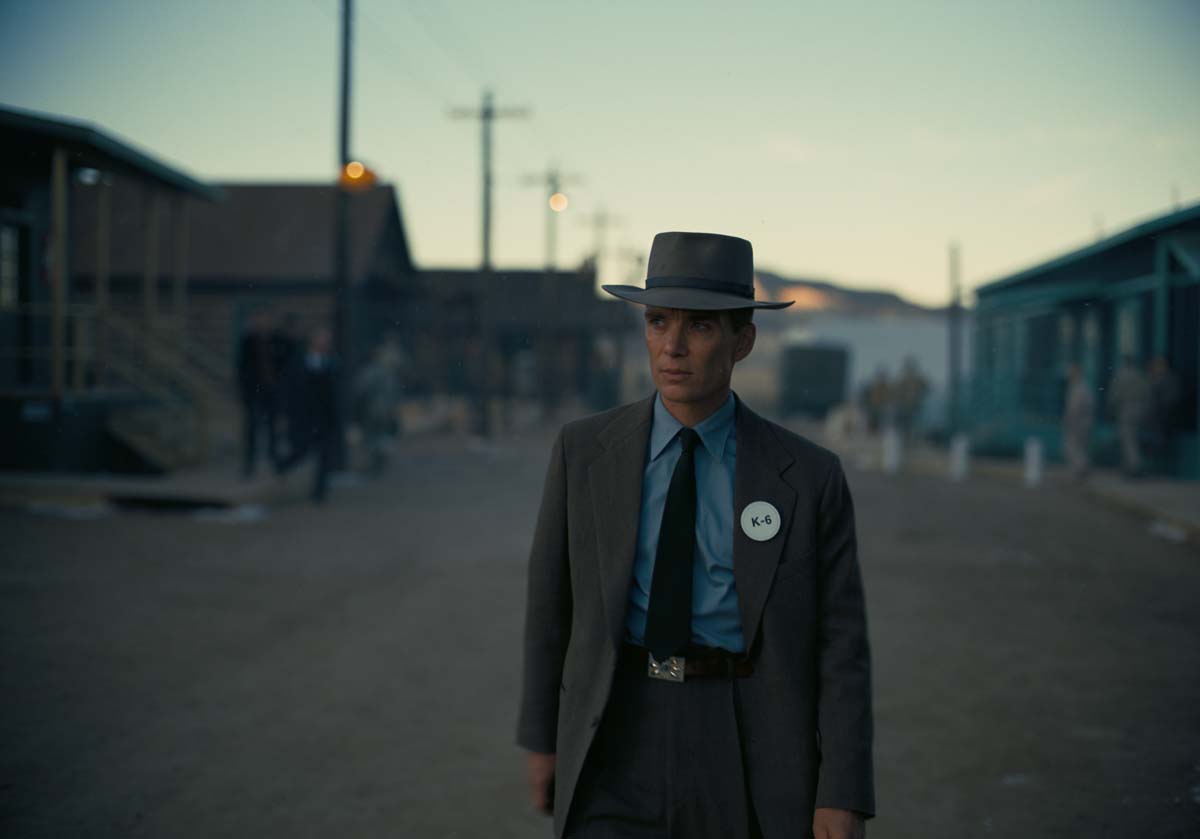
Did you have cards on a wall?
LAME: Yeah, we had a card board that he would walk over to often and sometimes we’d move things around. I want to give a shout out to Amanda Goodpastor, the music editor. We had two incredible music editors, Amanda and Felipe Pacheco. And when you're working at the pace that Chris works at with those Friday screenings, you need incredible music editors because he expects to have music in each of those screenings and expects them to be conformed nicely. And it's all Ludwig's music, whether it's temp or not.
It’s all music that Ludwig gave us. He has very high expectations for those Friday screenings, which I value and appreciate, but also causes me incredible anxiety. So having a team of people that can help make it go the best way so there’s not a mistake or something that distracts the 1 or 2 people that are there because you just feel that energy and it could ruin a screening if something isn’t right. Nick and Mike watch down the reels as we turn them over. It’s an intense but really fun and fulfilling process.
Jen, thank you so much for your time. I know you got to go off to a meeting. I'm going to hang out with Nick, Mike and Tom in your absence. Thank you so much.
LAME: Bye, guys.
Bye, Jen.
LAME: Okay, bye.
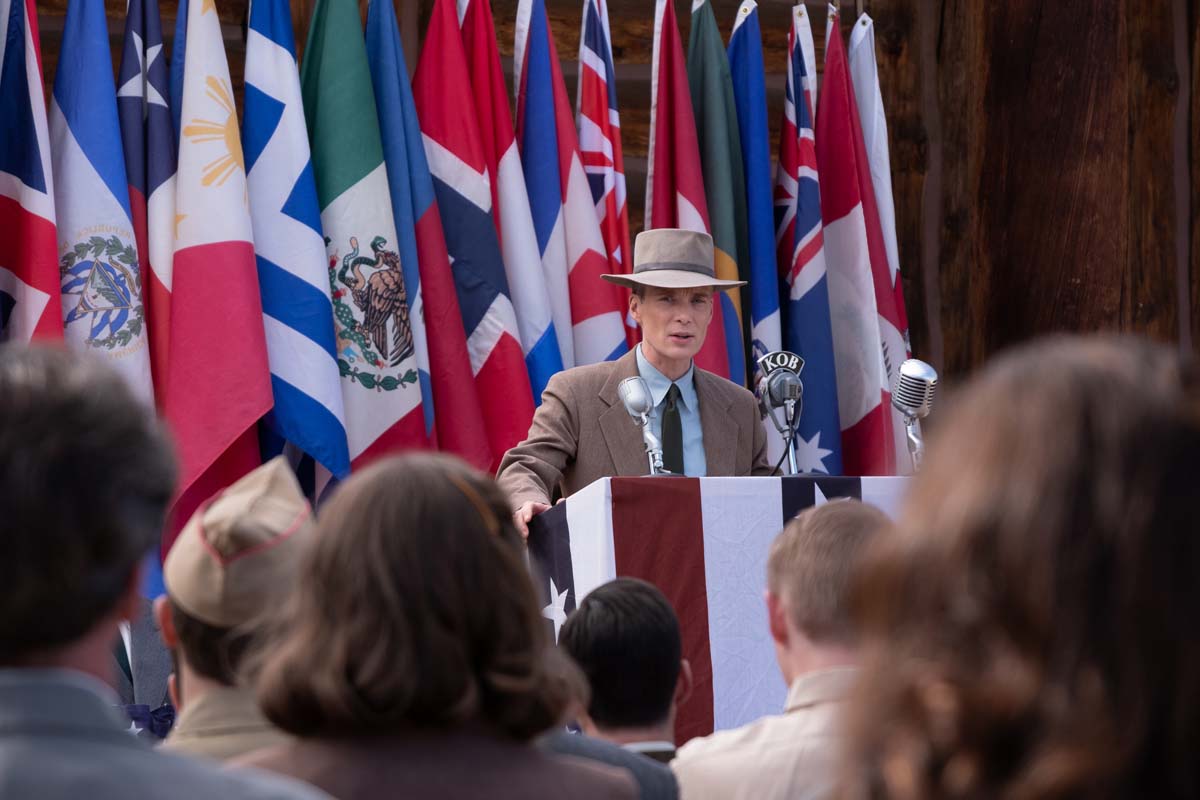
FAY: Bye. Jen. And we should also remember Alex Gibson who was another music editor. They were fantastic.
Nick, tell me a little bit about the organization of the film for Jen and for Mike, because it does sound very complicated that there are these scenes that are longer and performed longer, but then they're really broken down and they've got to exist maybe in two different ways.
ELLSBERG: And keep in mind, too, the two main formats also we have to keep straight and they also shot some 35mm. We had to figure that out as we went along. We luckily were standing on the shoulders of giants — John Lee, Eric Lewy — and others who had worked on the previous films. And we had another assistant, Scott Ross, who had worked on almost all of the films going back to Dark Knight — Batman days. And he was really, really helpful in explaining how they had done certain organizational things.
But every film is different, and you kind of have to figure it out as you’re going. So as we were talking about with Jen: figuring out how to get those scenes organized in a way that made sense, it was a sort of idiosyncratic process. They would shoot it one way, but then it needed to be edited in a different way, not just as a complete scene. The big thing was: how do we keep our timelines for our reels organized, knowing exactly what we’re sending to the film cutting room too — what lists we’re going to send — and making sure that they have the right pieces in the Avid timeline.
That’s a big part of the job for the Avid assistants is keeping that organized. We basically also had to make sure that at any given time you could watch the film in both the 2:20 5-perf aspect ratio and the IMAX 1:43 aspect ratio because the film switches back and forth between those. Obviously you only really feel that shift when you’re watching the film in IMAX. When it’s in the 2:20 aspect ratio, it just stays as one.
That was a big thing. And luckily through color coding systems — having different layers on the timeline — we were able to keep it straight. But with Chris, you can’t ever say to him, “Oh, sorry, that’s not ready to look at yet.” It has to be ready to go at all times. So when Jen and Chris are editing, Mike will go back in afterwards and make sure that all the proper masks and the proper extractions are turned on; will make sure that nothing has been slipped or extended past a cut point that was there before. That’s just a big part of it is just manually going through and just confirming that everything is in its right place. We had pretty good systems in place I think to catch all of those instances where things have gone awry.
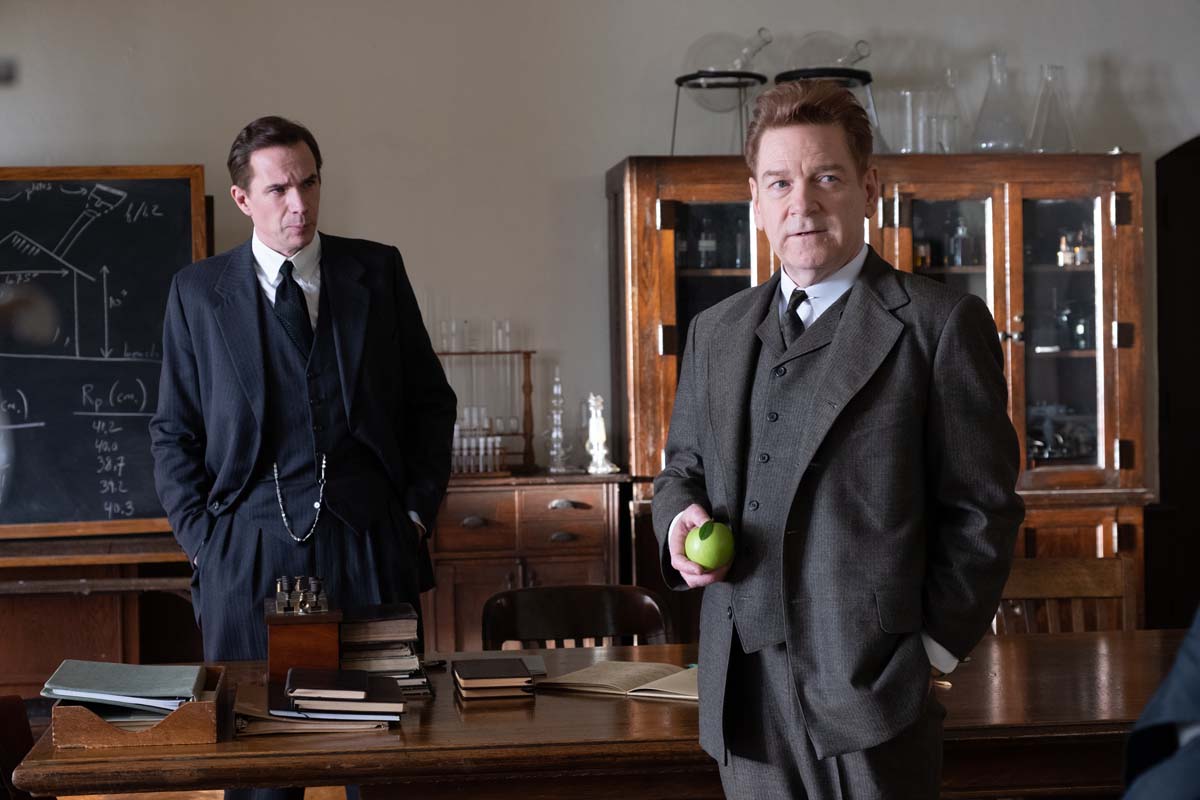
What about for those film screenings? Tom and and Nick and Mike, anybody that wants to talk about this, you're dealing with little trims that Jen and Chris must have done. You're dealing with reordering things, the sound. What do you have to do to be able to prepare basically a cut list to go back to Tom who's already cut it once, before the previous director's cut.
ELLSBERG: Well, change lists and change pull lists. And what we discovered pretty early on is that for a work print, you don't want too many splices in quick succession. It potentially causes problems jumping in the gate. But it's also just not a great way to view it. They were pretty good about trying to avoid any short extensions like one frame, two frames.
There are certain scenes where there are just short cuts built into the scene and that’s the way it’s intended to be cut: like four frame shots. Those we actually ended up doing — just for viewing purposes — as opticals. You’d actually print a run of three shots if they were cut in very short — like under eight frames — then later on, during the negative cut, they would actually cut the negative to that length.
But Tom and his team — Mike Wilson, Ray Boniker, Andrew Blustain — in the film Room, they had to manage a pretty substantial film library and had to come up with their systems for how they would easily quickly track down not just dailies, but also these optical extractions, other opticals, visual effects shots, 35mm blow ups.
FOLIGNO: We had two things: there were dailies that we would reference back to the edge code. Then we had extractions which were where those 15 perf pieces would be or 35mm pieces which we had very few of those, but there were a couple for VFX shots or particle things, but it went really smoothly. There were a few times when things didn't make sense numbers-wise, and we'd realize that, “Oh, when we originally logged that, we transposed a number.”
Or there were a few things like that that happened a little bit. Those were mostly on the 35mm when we were doing the IMAX negative cut — we had to prepare two different negative cuts — one was for the five perf and then the other one was for the IMAX and the IMAX we would take the 35mm reduction, which also did have the key numbers in there so that when we cut it all together, then we could send it to IMAX and they could conform the 15 perf negative to the 35mm print that we gave them. It went pretty smoothly. As far as trims go: that was a little bit of a situation because — and this happens a lot i the Avid — you’re just kind of moving things around. You’re working fast and you’ve moved something one frame and you can’t visually see it.
You can’t tell. It’s one frame shorter at the head and one frame longer at the tail than it was the last time I got it. So that right there is a flag and we’re like, “Whoa, wait a second. We might have to change that since we’ve already conformed the film.” We don’t want to trim one frame off and then add one frame on the tail because the aspect ratio we’re in — 2:0 — you can actually see the splices because the tape, although very skinny, once it goes up on that screen, which is 60ft high, even though on the bench it looks very small, you can see it really clearly. And so we want to avoid too many of those in a row.
Not only would it maybe jitter a little, but also it’s just ugly because you can see the tape, tape, tape. Just one piece of tape every once in a while is okay. So we had to do lots of reprints because these things occur and some of them are intentional. They want to lose that frame or want to add that frame, on purpose. So we would have to get — prior to all the screenings that we did — we took a look ahead to see on the lists what was going to be a two frame or one and did we need to reprint that whole take?
So it got a little crazy. But it looked great. I couldn’t believe that we did it because, like Jen said, anxiety about it breaking or you got the wrong shot in there. It’s easily could happen, right? Mean we check everything before it goes but a reaction shot? There’s no dialog. There’s no sync. That could be wrong, which we did have a couple, but not that it would ruin a screening. It wasn’t like a “put-your-coat-on moment. I’m going home.” We got it done.
And I knew that first screening was going to be super important because it was his first film screening with this new studio and he needed to sell it. He needed to say, “This is how I do it and here’s why.” They were blown away. So I think we really accomplished what we wanted to do there.
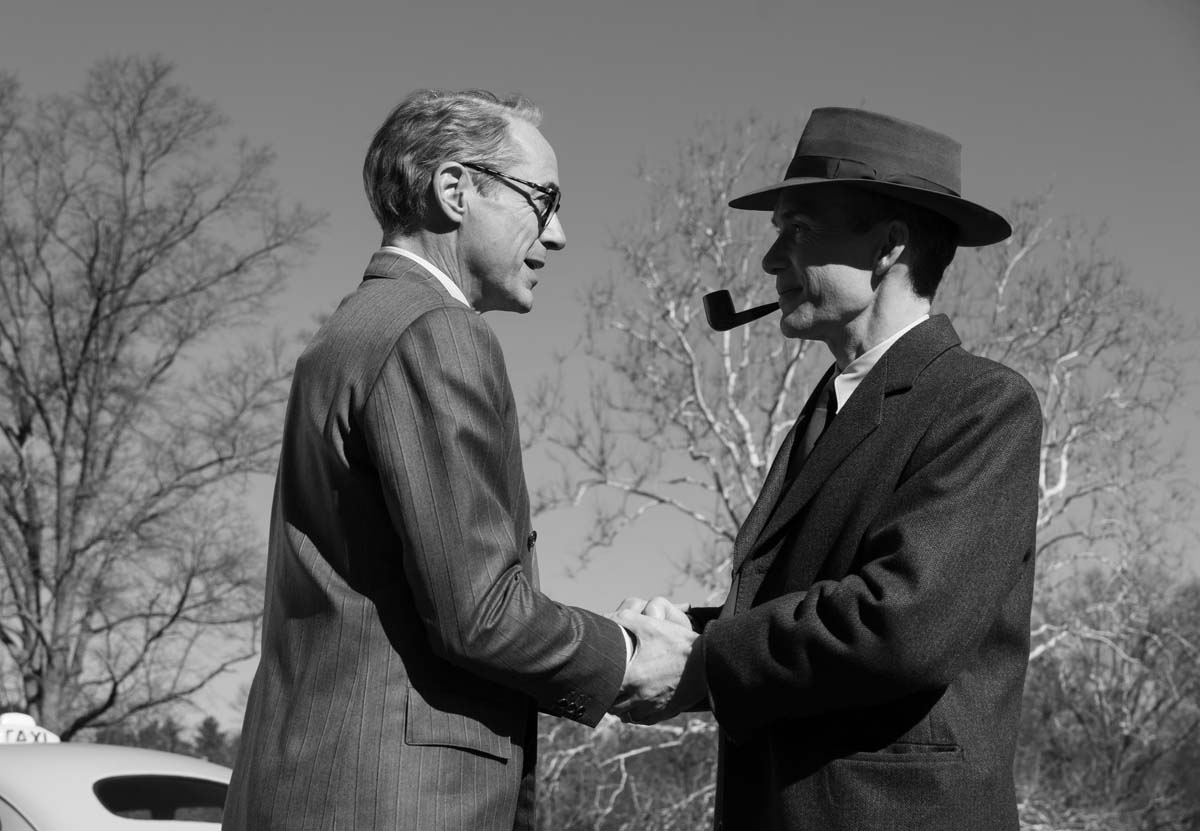
FAY: We all threw a massive party after the director's cut screening went successfully.
ELLSBERG: At the time, it seemed like this was a hugely climactic moment, which in many ways it was, but it was just the beginning of a really long process. Each successive step was more complicated than the last. It's extremely satisfying to get to that point and see it up there. When you complete that screening, that's a really good feeling because it is such a team effort between the lab, between the editorial and obviously the creative process that's happening surrounding that is so intense, but the technical side of it kind of matches the intensity of the creative process, which is not usual. On most digital shows that's not the toughest part of the job — getting the director's cut screening ready.
It sounds like you could relate to the whole Trinity countdown thing. Pushing the button on the atomic bomb was like rolling the projector in the director screening.
FAY: We did have our fair share of technical challenges in the heat of the moment, moments before we're supposed to roll. There's something about that — raising the stakes for the screening that really did have an interesting effect on everybody involved. Feeling that the film could break at any moment. I think I felt that every time we screened, I think everybody did. But there's something about it — that also coupled with those self-imposed deadlines of a weekly screening or the self-imposed deadline of “we're going to do it this way,” it gets your own brain out of the equation and you just have to perform. You just have to get it done. Chris spoke about this at one point and he said, “It has such value for me. I know it helps people do better work when there are these self-imposed deadlines” and I've heard of this and I've done this on other shows as well, but never to the degree that we did it on Oppenheimer. And it's something I've come to value tremendously because you can see how, when you push yourself and you push everyone that you're with and you can get everyone to just get their minds out of the equation and just do it, you can really get down to the nut of it and the most important part of it and the work can really excel. So that was, I think, a big takeaway for me of this whole process. Yes, it's extremely high stakes, but it's high stakes for a reason.
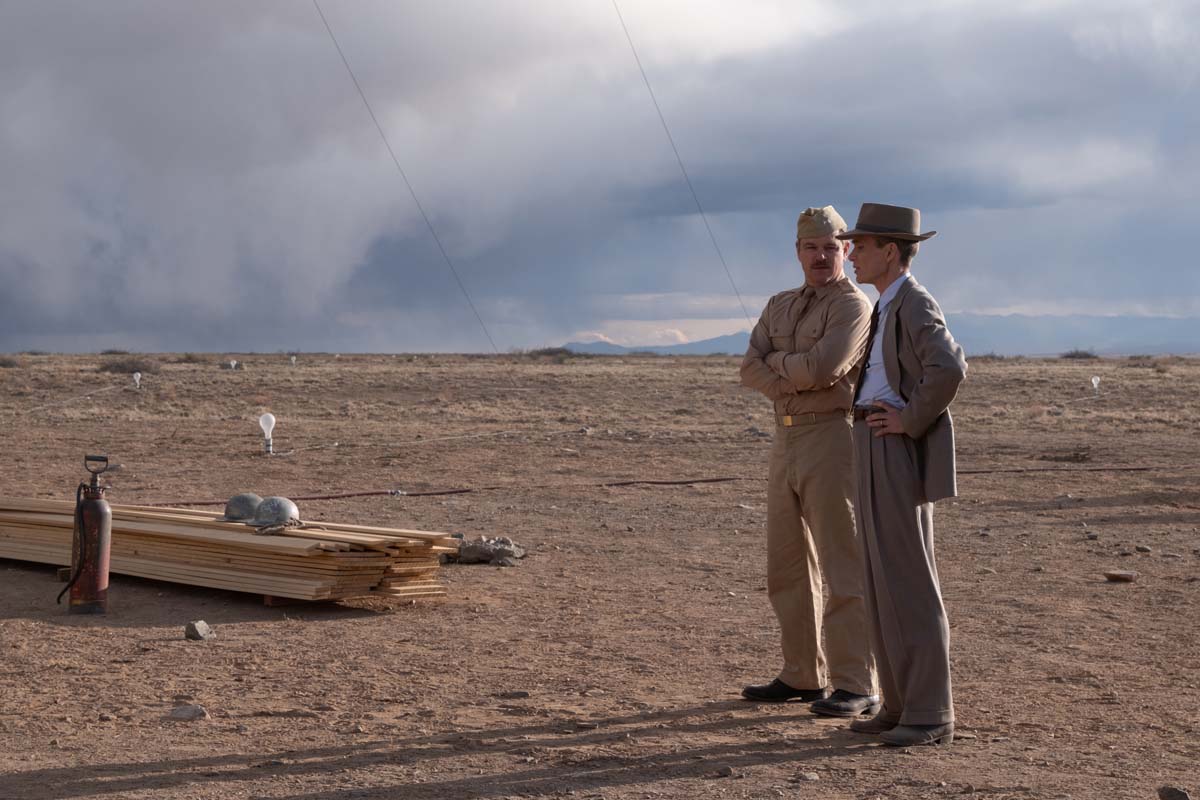
FOLIGNO: It's like drawing where you have to sort of turn off one side of your brain. One side of your brain is logical and wants everything to have a name. The left side is artistic. So doing this, I think, Mike, it seems to me like he's pushing toward left brain activity only during the week up to Friday. You don't have to be logical. You just have to get into it and do it.
FAY: I don't even know if it's so much left brain or right brain. I think really what he's drilling down into is instinct. Don't overcomplicate it in a way — ten different options — go with what your gut tells you. I heard Michael Kahn say that: “Trust your gut.” That's your barometer as an editor, That's your barometer as a filmmaker: go with your instinct because your instinct is generally the right thing and I think that's what he's really getting at.
Any final great stories you want to wrap up with?
ELLSBERG: How we all ended up on the movie is actually kind of funny. As you know, John Lee had been doing this for 15 years, something like that, and was pretty indispensable to the process, and then he got an editing job and, told Chris, “I'm not available to do this.”
He was on Black Adam, I think, right?
ELLSBERG: Exactly. Jen was tasked with finding the replacement. She got Mike's name and talked to him and asked him, “Would you be interested?” We were working together on Bullet Train at the time, and he told me, “I've got something really big coming up. I can't tell you what it is, right now, but just keep it in mind if you're interested.” I thought, “Well, what could it be? What could be bigger than what we're doing?” Then I thought, “I bet it's a Chris Nolan movie.” And sure enough… it all came together. Tom is our friend. We worked together with Tom for years now. I said, “We got to get Tom in here.” He knows film. He’s from the Marty Scorsese camp. He worked on film for many years. It had been a long time. You got to get Tom in there. And everything kind of just coalesced from there. That montage scene of recruiting the scientists? That was Mike's life for real for about 3 or 4 months between October of 2021 and January of 2022.
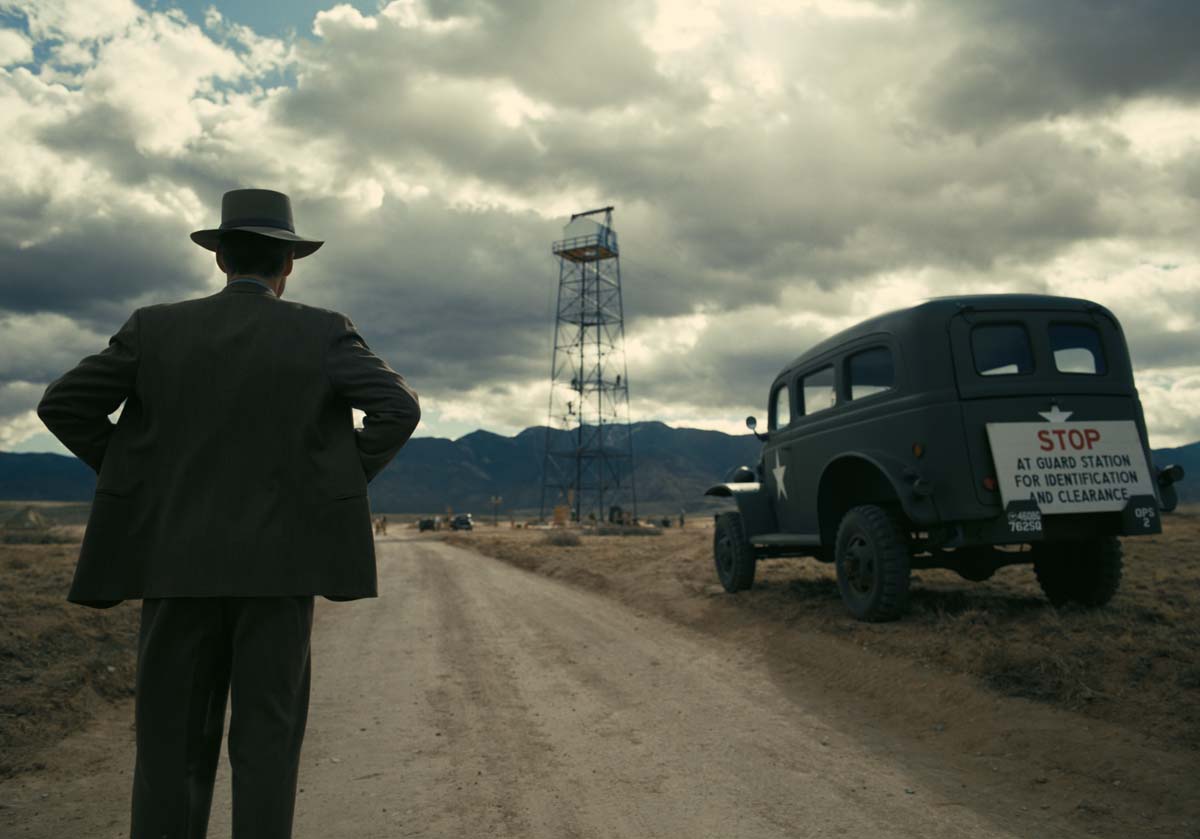
Did you cut that nonlinearly or did you cut it linearly? You know the gathering of the editorial team?
ELLSBERG: Oh, it all had to be cutting non-linearly, of course. The sheer number! I mean, I've never worked on a film that had this many people working in editorial, but also all the logistics. Mike had to be involved in pre-production in a way that editorial is not usually involved in figuring out the logistics and really producing this whole side of it that was really sort of amazing to see.
Mike, how many people was it?
ELLSBERG: We had 9 or 10 assistant editors.
FAY: On the Avid side. Yeah, I think it was about 13 total. It was a massive team, but it was also a massive family. We all bonded so tightly on this film and everyone was so cool and we would have these massive lunches. Like I said, we had a massive party after the director's cut. We would do that like periodically after these big milestone screenings. It's just a great group of people.
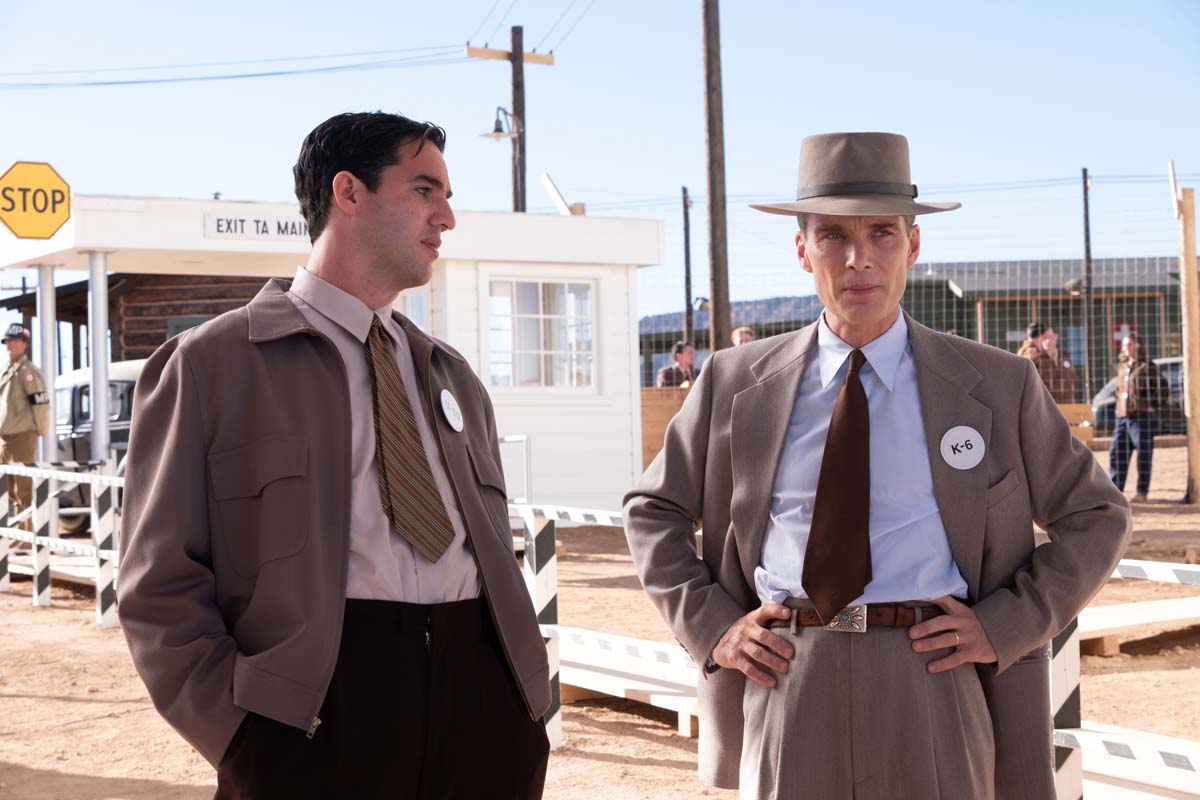
FOLIGNO: What you took on, between the lab, the trailer for screenings, the Avid stuff, you really coordinated all that stuff. It boggles my mind what you did.
FAY: It boggles my mind! To Nick’s point we had John and Eric and the guys who came before us — the team that came before us — luckily, I had you guys. Tom, when we had a change happen with the film team — which was really upsetting — and when that happened, Tom, you really were able to step up. And I remember thinking, “Oh my God, if Tom can do it, think I'm going to be okay?”
FOLIGNO: You put together the perfect team. I don’t want to pat my own back, but…
ELLSBERG: Mike was Groves. Jen is Oppenheimer. I was definitely Teller — not the team player — I just wanted to work on the hydrogen bomb.
Gentlemen, thank you so much for all the time that you spent with me. It's so interesting hearing about this film. What a great piece of cinema. You guys really got to work on a classic. I'm grateful for your time with Art of the Cut today.
FAY: Thanks, Steve. We're happy to do it.
ELLSBERG: Thank you very much.
